







It’s we what do
Think about what it’s like to finish a really long, tough ride on a great bike – that feeling of accomplishment as you kick the stand down, you know it’s over, and you made it to the finish.
As you walk away you can think back on help you had from great people, big obstacles overcome by either sheer determination or a flash of clear thinking – or plain luck – slogging it out through
tough sections it was likely you might not survive, and dealing with flat tyres, mechanical problems and crazy, impossible situations no one could predict. You had no idea when you started how huge the challenge would be, and while it was all happening you were either enjoying yourself so much, or so worried about the problems, you didn’t really think about it. You can remember plenty of highlights on the ride, of course: fabulous moments of elation at superb scenery, sections of fast, swooping, loamy curves with the throttle wide open, and sunsets and sunrises fit to break hearts.
But it’s not until you shrug off the heavy, dusty jacket, ease the buckles on the boots and sit somewhere comfortable you begin to reflect – that’s when it dawns on you just how fantastic and special that ride had been, and how it’s one you’ll think back on for the rest of your life. You wish you weren’t at the finish, even though the finish is the moment of triumph.

That’s where I am as I write this.
This is my last issue of Adventure Rider Magazine all the feelings and emotions of having completed the ride of a lifetime are overwhelming. There has been no more important and amazing group of people in my working career than the contributors and readers of this magazine, and being accepted by the community of Australian adventure riders has been huge.

But there it is. Next issue there’ll be a new editor and the magazine will belong to a new company.
“ It’s not until you shrug off the heavy, dusty jacket, ease the buckles on the boots and sit somewhere comfortable you begin to reflect – that’s when it dawns on you just how fantastic and special that ride had been. ”
The new owner has been very generous in seeking my thoughts on the future of the magazine, and I suspect there won’t be monumental changes, but I’m the first to say some new ideas will definitely be good.
It does feel as though I’m walking away from something wonderful and amazing, and now, with a little time to actually look back at the whole mind-blowing experience, I begin to see how fortunate I’ve been to be part of it.
I’ll still be riding, and I doubt I’ll ever head out without a camera or come back without a story, so there’s a good chance I may well join the ranks of Adventure Rider Magazine contributors. As sad as I am to leave the editor’s desk, it would be a group I’d be very proud to be part of. Make sure you flag me down and say hello if we cross trails somewhere. Thank you to everyone.
This lightweight, electronic vest is fully wireless and autonomous, meaning there are no sensors needed on the bike.
Designed in association with award-winning motorcycle airbag company In&motion* it protects the thorax, abdomen, spine and neck. The Ai-1 Rally Airbag Vest is the only 5-Star SRA-Certified smart airbag, Europe’s top safety rating available, with detection + inflation time under 60 milliseconds.
Join some of the top Dakar riders in the world who choose the In&Motion Airbag system for the ultimate level of protection. Available in Australia from Adventure Moto
*Subscription applies. Check our website for details.

A COMPLETELY KITTED OUT
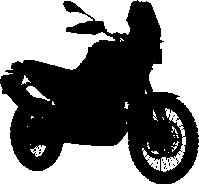
ADV BIKE



Adventure Moto is Australias leading adventure motorcycle specialist for gear and accessories.
100% Australian owned and operated giving the right advice for 15 years and the only Klim stockists to offer our exclusive Size Fit Guarantee.



Adventure
COO Christine Clancy
Sales Director
Bradley Buchanan
Editor
Tom Foster tom.foster@primecreative.com.au
Production
Arianna Lucini
arianna.lucini@primecreative.com.au
Design
Danny Bourke southern-bear@bigpond.com.au
Subscriptions
Phone: 1800 995 007
Website: www.advridermag.com.au






8 advridermag.com.au



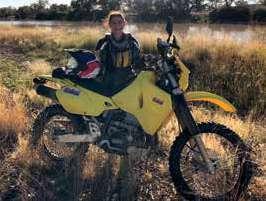


A ‘circus’ bear, spawning salmon, a lazy beaver and an inquisitive squirrel awaited Don Bromfield as he planned his return to Canada’s Cariboo, Chilcotin and Coast areas of British Columbia.
u


Three weeks of riding an almost unlimited selection of adventure beckoned: coastal rainforest, snow-capped mountains and arid open-range grasslands were all calling. It’d been four years since I’d stored the KLR at a friend’s farm near Merritt in the Nicola Valley of British Columbia. My ride commenced with a run north on minor roads, past Kamloops and the western arm of the Thompson River, before turning west on Highway 24 at Little Fort.
The gravel ride to Mahood Lake and Falls in Wells Gray Provincial Park took me to my night’s camp south of Lac la Hache, and there the real fun began as I headed into the wilds on the gravel of 108 Horsefly Road. My navigation skills received an early test with junctions not always signposted on the little-travelled road, but BC Backroad Mapbook and Garmin usually sorted out the problem if the sun was in the wrong direction.
“A stop at Witset Canyon introduced me to First Nations salmon fishing. Rod and reel? Why bother? With a long aluminium pole and net you can scoop the salmon like leaves from your pool!”
After lunch at Horsefly it was onto the Forest Service Road (FSR) for a run to Likely, deep in the Cariboo historic goldfield area. Evidence of long-abandoned hydraulic sluicing still scars the area’s hillsides, once rich in alluvial gold. Flashes of red – not gold – in the roadside stream drew my attention as migrating salmon battled the fast current and tumbling
Take on everything Australia has to offer with the iconic BMW GS range. From outback adventures to tassie trails, right through to taking on the top end - be prepared for any challenge with the ultimate reliability of the BMW boxer engine under your command. Discover the range at your local BMW Motorrad dealer, and get out there today... #MakeLifeARide
Learn more → bmw-motorrad.com.au/adventure
rapids. It was the first of many sightings for the trip.
Barkerville via the 150km forested backroad was my destination for the night, so, with a panoramic backdrop of the snow-capped Cariboo Mountains, on I rode.
Barkerville and the nearby town of Wells are steeped in mining history. Now developed as a tourist attraction, Barkerville has a streetscape of historic weather-beaten timber buildings and mining relics, and locals dressed in period costume offer entertainment and history to the visiting tourists. In contrast, brightly painted Wells is a working community, and it was there the next morning, at the General Store, I was cheerfully told Wells “…doesn’t do breakfast”.
Carving up
From Wells it was west on Highway 16 for my run to Prince Rupert and the ferry to Haida Gwaii.


A stop at Witset Canyon introduced me to First Nations salmon fishing. Rod and reel? Why bother? With a long aluminium pole and net you can scoop the salmon like leaves from your pool! As I watched, a First Nations elder related to me that the runs are now around half of what they were in the 1970s, and that these days he buys his salmon rather than catching them.
Also worth seeing is ’Ksan Historic First Nations Village and Museum of the Gitxsan in nearby Hazelton. This recreation of a traditional village is replete with large, decorated housefronts and totem poles. Further west and the rain began. Drying wet gear in a Prince Rupert motel led me to realise I had to change my plans, as the forecast of a week of steady rain made me decide to forego the seven-hour ferry ride and days of wet camping on the Haida nation islands. I had to reluctantly accept Haida Gwaii must remain unfinished business, but it will be done as I’ve long admired the Haidas’ superb wood carving skills, rich with their totems of bear, eagle, orca, salmon and raven.
Pour show
Two-hundred-and-fifty kilometres of steady rain awaited as I set off back east the next morning.
I was determined to make the most of

the ride despite the relentless downpours, so I enjoyed the waterfalls streaming off the coastal mountains, foaming mist and spray, white against the shining black of sheer rock faces. Deep green forest, dripping with the rain, tested my resolve as I tried to set up my phone for a time-delay photo before I was finally rewarded with some moody shots on a narrow side trail.
Rosswood General Store on the Nisga’a Highway provided a much-needed warming cup of coffee to go with a yummy cinnamon bun from Joan’s next door. Then it was time to sit on the verandah with the store owner for a pleasant conversation about the state of the world as we watched the never-ending rain.
Bear essentials
The next day, while following the Babine Lake Road towards Granisle, I chanced
u

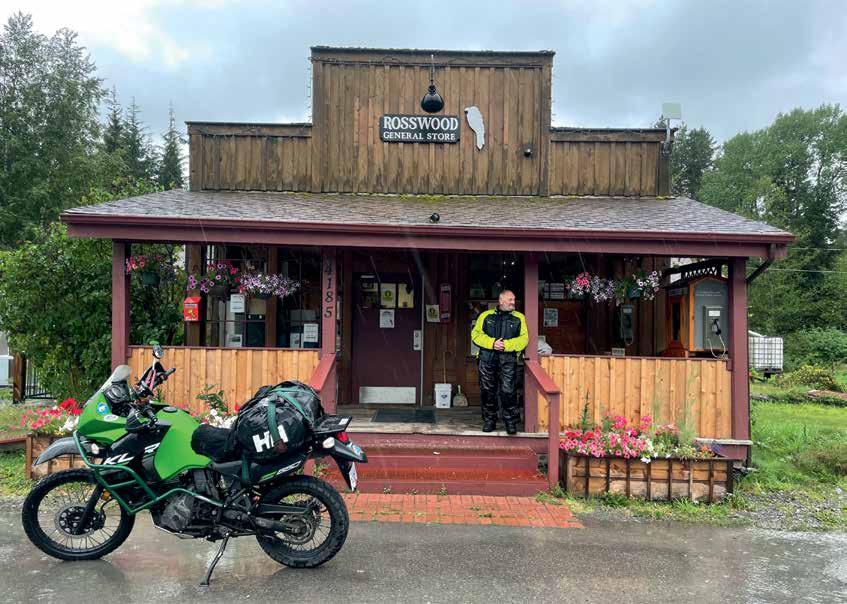
upon the work of one lazy beaver. It had built a lovely pond using the berm of the FSR to anchor the end of its dam wall. I suspected the water would soon encroach on the road and I imagined a visit from an excavator would follow.
These roads are not called FSRs for nothing. I met more logging trucks on this road than on any of my travels throughout Canada. Active FSRs are often heavily gravelled to help with traction for the trucks, but have the opposite effect for us riders. It was around this time I started questioning the suitability of my tyres for the remainder of the trip.
South of Houston, I turned in to the forests on the scenic Francois Lake Circle Tour. The gravel road climbs high above the lake, protected from the steep drop by concrete barriers. Little did I know it was circus-bear time.
How do you describe the hilarity of a fat, hibernation-ready, black bear perched precariously on the concrete roadside barrier as it prepares to cross the road? It wobbled and shook and waved its head in WTF confusion as it realised something strange and green was pop-popping
“The campsite and sunset at Bobcat Lake were stunning, while a nosey squirrel provided light relief. Inquisitive by nature, this little fellow rushed up the trunk of a fir tree to check out the eagle that had just landed atop the branches.”
wide-eyed bear head, briefly suspended above the barrier, before it was gone.
I’d planned to cut the corner between Vanderhoof and Quesnel, so called in at the visitor’s centre to enquire about the route.
“Follow the highway,” was the advice.
“It’s pretty”.
‘Mmm? Pretty boring,’ I thought from my previous experiences on that stretch.
So onto the Telegraph Trail Road I headed for 150km of fantastic riding.
towards its intended path. You could clearly imagine the cogs turning over as it processed its options, all the while trying to keep its balance. Fortunately, the flight response won and it plunged, bum-first, off the barrier and down the precipice.
I had one final view of a still-startled,
The campsite and sunset at Bobcat Lake were stunning, while a nosey squirrel provided light relief. Inquisitive by nature, this little fellow rushed up the trunk of a fir tree to check out the eagle that had just landed atop the branches. At two metres distance it quickly adopted the bear’s option and retreated, fleeing the eagle’s watchful stare.
It’s difficult to capture wildlife photos when riding. You have to stop the bike,


take off your gloves, get your phone out and key in the code because the phone doesn’t recognise the alien in the helmet. By that time the bear or deer has sidled off into the bushes, keen not to become your next trophy.
saw six bears on this trip and managed to get one photo of a black blob 100m up the road.
Sidetracked
I began searching for a replacement for my worn tyres as I headed further south. Spectra Powersports at Williams Lake


grizzly salmon-fishing country.
A spectacular view of the snow-capped Tweedsmuir Mountains, towering above the rainforested valley, all tinged by a golden sunset and a quarter moon, kept me out of my tent as I savoured the spectacle.
Early morning added a thick blanket of fog to the valley to complement the view.
Spooky
Bella Coola is on a coastal fjord facing the Pacific Ocean, so obviously it rained. What to do?
Chase waterfalls of course, with the 25km Nusatsum FSR run to Odegaard Falls filling the bill.
came to my rescue with the promise of a set of Mitas E09s, but a long weekend meant I had a four-day wait before they could be fitted. Logic dictated a run out to Bella Coola on the coast to fill the time. I had done the same ride in 2015 and knew Highway 20 could be a bit ho-hum, so decided to explore the options offered by the multitude of sideroads into the Chilcotin wilds. A plan for a fast run out and to explore at a leisurely pace on the way back saw me camp the first night at the top of ‘The Hill’: Heckman Pass. Any further would’ve landed me in prime
Perspective was provided by the fir trees receding into the mist on successive ridges towards the Odegaard cataract which plunged over the mountain, dwarfing the trees on its flanks and throwing a mist of its own high into the clouds.
More side roads followed with the Farwell Canyon-Big Creek loop providing some company when I met two Albertans riding Tigers on the sketchy descent of the heavily gravelled run into the canyon. This loop took us into the north of the vast Chilcotin ranchlands and west of
Purchase a brand new MY21 Pan America™ before 2023 and choose between:
Escape to Cape York, Queensland on a two day, all inclusive, off-road adventure. Experience the best trails and tracks Cape York Peninsula has to offer on this tour lead experience.
Kit


Main: The mighty Fraser, south of Quesnel. Right: Not what you want to see when you’re looking for a campsite. Far right: Gravel and logging trucks. What’s not to like?
Below: The mighty Fraser River




the mighty Fraser River canyons. A fellow adventure rider later described this Gang Ranch-Big Bar area south of Highway 20 as the ‘Chilcotins Bermuda Triangle’. While it didn’t claim me, it certainly gave cause for concern a few days later.
Geographically embarrassed I was revelling in my new-found control and traction (a KLR power joke) after the guys at Spectra fitted the tyres when a missed turn at Dog Creek led me into a 50km maze of forest nothingness. My Garmin was of no use as it tried to send me down roads that didn’t exist. It’s a forest and areas had been revegetated. After an aborted 10km run down an increasingly gnarly forest track the Garmin had suggested, decided to take stock.
A stop with a drink and a bite to eat as I pondered my map book cleared my head and helped decide on a course of action.
Eventually I was able to navigate my way out of the labyrinth and on to the road towards Clinton. My philosophy for this trip was exploration. There are, however, limits to how far I was prepared to push on the wilderness trails. On several occasions I set a limit of 25km for worthwhile scenery or I would turn around to head back. Safety and the thought of loved ones back home were at the forefront of my mind.
To finish the tour, I decided to ride from my campsite on Kerry Lake near Clinton, over the mountain to Pavilion, then onto Lilloet, Gold Bridge and Pemberton. These two days provided some of the best adventure riding I have ever experienced.
The climb from Kerry on the 15-per-cent grade, through forested hairpin bends, set the scene for the short run on the saltbush cattle-range plateau above. A stop to check out the nesting boxes perched on the fence posts punctuated the morning run. The next stop was a real gem, the Lilloet Bakery, with pastry and coffee worthy of a Melbourne lane. With a full tummy I climbed the spectacular 50km of winding gravel high above Bridge River, always wary of the ever-present rockslide danger.
A short detour to Yalakom Recreation Site was rewarded with a further salmon run of vivid red sockeye swimming in the rocky shallows.
A well-maintained BC Hydro sealed road completed the run along the tourquise
u
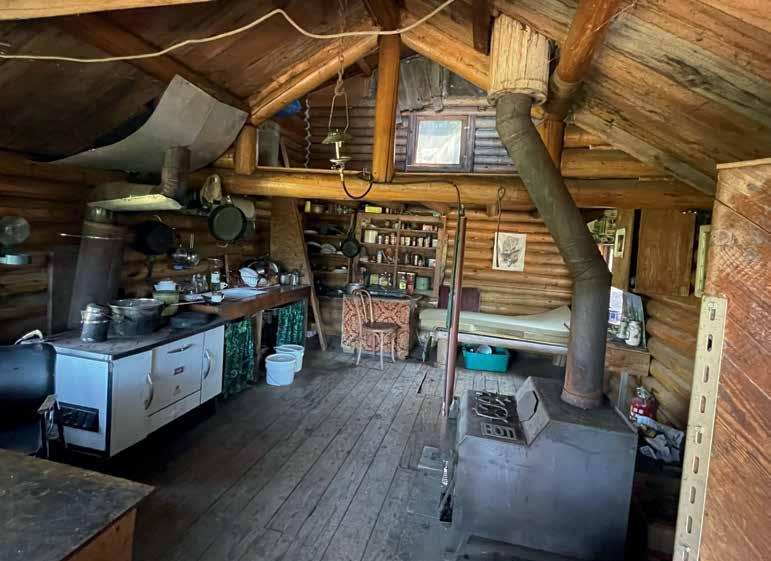
waters of Carpenter Lake into the mining village of Gold Bridge and my camp at Gun Creek.
All welcome
The next morning the Gold Bridge General Store was yet to open so I decided to ride to nearby Bralorne to try my breakfast luck. Coffee, a muffin, and a conversation with a few of the 120 locals (60 in winter) at the pub elicited advice on the mining history and relics to be found nearby. I already knew of the abandoned town Bradian, slowly succumbing to the woods, and the Pioneer Mine with rusty steel and tangled timbers, but had no idea there was an abandoned trapper’s cabin nearby.
After viewing the first two sites it was onto the FSR in search of the branch road leading up through the forested hills to the cabin.
Words are difficult to find to describe the perfectly preserved log cabin, nestled into the fir trees on the edge of a deep gorge with panoramic views to distant
snow-covered mountains. Even more startling was everything was left as if the trapper had just stepped out to check his trap line. Snowshoes and a woodenframed canvas pack adorned the front wall, and all the pots and pans, table and chairs were neatly arranged inside the unlocked front door. The trapper’s friendly poem posted on the door invited all to enter and respectfully make use of all the cabin had to offer. ‘Could a scene like this survive in Australia?’ pondered as I wandered in admiration through the cabin and surrounds.
Shall return
At this point my journey was nearing its conclusion.
I rode down the steep grades of the Hurley FSR on loose gravel, dodging

pickups and SUVs ascending with their passengers for weekend outdoor pursuits. Pemberton provided a rest stop before the long ride through fire-devastated Lytton and back in to Merritt.
As I settled into my airline seat on the flight home I had time to reflect on my three weeks of adventure. Yes, the rain had made for a soggy few days, but the unique wildlife, the friendly locals, and, above all, the magnificent scenery on the almost unlimited adventure-riding roads had made the long wait worthwhile.
As the wheels lifted from the tarmac I knew I would be back.


Aussie adventure riders have been champing at the bit to get their hands on Ducati’s DesertX. Maschine’s Nick Selleck put 2022’s hottest property through its paces.


Put yourself in the shoes
You are the CEO of the successful Italian motorcycle company Ducati that has a rich heritage in racing and road bikes. The guys from the Scrambler team present to you a design sketch of a retro-looking Dakar replica motorcycle that clearly has knobby tyres. Sure, adventure bikes are popular. But Ducati doesn’t really do knobbies. Ducati wins on the racetrack.
What do you do if you are Claudio? Do you green light the next expensive step of the project and build a prototype?
Now imagine yourself in my shoes for a minute.
You’ve been running adventure-bike tours for 11 years. Your job is riding adventure bikes, organising tours, showing people all the awesome places around Australia, and even doing the occasional tour overseas. You have an established relationship with another motorcycle manufacturer that gives you a new motorcycle once or twice a year, and in turn you help promote their brand.
Dream job huh?
Yep!
Now imagine you’re approached by the people at Ducati and told they have a new
Top: 110hp means there’s enough power on tap to loft the front wheel at will.
Right: Ducati allows the rider to completely customise a range of seven different parameters within the six modes to suit individual riding styles or conditions.
adventure bike coming and they would like you to join their team. They ask you to come on board and help them promote their yet-to-be-seen, let alone released, new adventure bike. You haven’t seen the new bike and Ducati isn’t known for building off-road orientated bikes which is your bread and butter.
What do you do if you are Claudio Domenicali or me? Take a leap of faith and trust in a brand that has been building gorgeous Italian motorcycles for over 75 years?
I’ll save you suspense and tell you the answer to both was, ‘Yes. Let’s do it!’ Both projects got a green light. A super green light in fact.
Ducati unveiled a concept based on a Scrambler platform at EICMA motorcycle show in 2019: the new DesertX. It got a massively positive response, so back at Borgo Panigale they got busy turning the concept into a production motorcycle. Along the way it went from being a Scrambler model to being a Ducati –which meant it become sharper and more performance-oriented. In my eyes this was a good thing. We all got to see the Ducati DesertX in late 2021 with a series of teaser videos showing the bike ripping in dunes and on a motocross track at the hands of Antoine Meo. It grabbed everyone’s




“Suffienct
You can focus on your journey while Touratech protects you and your bike on the road.
30 years of product development and thousands of kilometres testing will enrich your experience as a rider. More than one million panniers produced in the Black Forest, Germany. Decades of heavy usage on the roughest tracks of the planet. You can rely on that. Experience counts. Get your gear here!
attention and there was a lot of talk about the new Ducati.
How is newcomer Ducati going to stack up against the competition in the adventure market? More importantly, the burning question, how is a Ducati going to survive the harsh reality of Australian bush and its outback?
Okay, let’s dive deep into the new Ducati DesertX.
Let’s start with the powerplant.
Like all good Italian motorcycles it’s a V-twin – a liquid-cooled, 937cc Desmodromic Testastretta engine offering 110 horsepower and 92 Nm of torque. Technically, Ducati likes to call it an L-twin because the two cylinders are configured in such a way the rear cylinder stands up vertically and the front cylinder lays down horizontally.
The L-twin setup adds to one of the great handling aspects of the bike – a low centre of mass.
The lightweight feeling of riding the bike belies its look. The white fuel tank seems to sit up high, but in reality the handling is superb and the bike has a really flickable feel.
The other benefit of a V-twin is them being so narrow between the legs, and that’s absolutely true with the DesertX. Standing or sitting, this is one slim bike.
The tractable nature of the V-twin driving over erosion bumps and just trying to lift the front wheel while still driving forward is excellent. Equally, 110hp means there’s enough power on tap to light up the rear wheel at will and get a nice slide going.
Also, it’s easy to loft the front, certainly in the first two gears, without any clutch, and you can still send it skyward in third if you time your inputs correctly.
Mating up the power to the rear wheel is a six-speed gearbox with the awesome Ducati Quick Shift for clutchless shifts once moving. Like most quick-shift transmissions it prefers to be abused and will treat the rider with sweet, smooth shifts the harder the bike is pushed.
Although the DesertX is ‘all new’, the 937cc Testastretta engine has been in the Ducati family line up for around 15 years in various models, and it’s proven technology.
It’s impossible to discuss the engine

without talking about the exhaust note. Like all Euro 5 compliant bikes it’s stifled in standard trim, but there’s still a taste of that V-twin with nice little cackles when shifting. Opt for the gorgeous Termignoni full-race exhaust and the true character comes out in addictive pops and cackles without being at all offensive cruising open roads or through towns. Tick that box.
One of the real standout features of the DesertX is the electronics package. There are six riding modes, and the most sophisticated electronic rider aids of any motorcycle I’ve ridden. That’s really saying something when you consider the other bike currently parked in my garage is a Multistrada V4S.
I mean…the V4 has frikkin’ radar cruise control, but the DesertX riding modes go way beyond the Multistrada offering.
Ducati allows the rider to completely customise a range of seven different parameters to suit individual riding styles or conditions. The settings include:
v Power output from 75hp to 110 hp
v Throttle response
v Ducati Traction Control slip level (eight levels or off)
v Ducati Wheelie Control (eight levels or off)
v Ducati Quick Shift (on or off)
v ABS (three levels and completely off using the button on left hand switch block)
v Engine Brake Control (two levels)
To customise the settings you need to be stationary, but once riding its easy to switch between the six riding modes on the fly with about three button presses and a close of the throttle. The other great thing is the bike retains the last setting after turning off the ignition or stalling

the bike. There’s no more having to reset electronic modes every time the bike is started.
Suspension and damping were a discussion point during and after the first day of testing on the Australian media launch. Most of the review bikes had around 500km on them as they left Sydney, and frankly that’s not enough kilometres for the suspension to bed in and operate smoothly, especially the forks.
My personal bike had over 1800km on it and the forks and gearbox were running noticeably smoother.
Suspension action is another standout feature of the DesertX.
The KTM 890 Adventure R was my previous benchmark of suspension performance in the adventure class, and I thought it was without doubt classleading. I’d say the Ducati is right there with the KTM in terms of suspension. But dare I say it, the Ducati may even have the edge. It’s a little more supple in the initial stroke and I think it’ll suit a wider range of riders.
Standard spring rates were perfect for me at 75kg, and I believe they should be okay for everyone up to about 95kg-100kg. Beyond that it might need a chat to a suspension tuner about some heavier springs, but the majority of riders will be in the sweet spot for spring rates with enough preload adjustability both front and rear.
So many Ducati’s past and present hold their bits together with these steel trellis frames. There’s some true nostaligia in the design, but there’s also some serious practicalities. The rear subframe is narrow and
u







base dry-weight number is 202kg. Add a full tank of fuel and we’re talking around 220kg loaded ready to ride. That’s in the ballpark.
Frankly, the feel is awesome, and something everyone who rides the bike comments on. They are surprised at how light it feels.
I’ve had a few rides now where I’ve spent more time sitting on boring blacktop than I normally could endure. But even after stints of 2.5 hours in the saddle I was totally comfortable. I really didn’t feel the need to wriggle and shift position or stand on the ’pegs to relieve pressure on my buttocks.
I can’t even sit still in my office chair for that long.
Height wise the seat is bang on for my 178cm and shortish legs.
The windscreen provides a good cocoon. Although it’s not adjustable, it does sit quite a distance ahead of the rider, and that helps throw the air up and over. Of course, taller riders may have a different feel. I did have some buffeting issues wearing an AGV AX9 helmet, I think due to the solid peak. I don’t normally feel any buffeting when wearing my usual Alpinestars SM10 helmet, so I’d say the combination of screen and helmet should be considered together.
The bike is supplied with Pirelli STR tyres, which are fitted OEM on many other manufacturers’ bikes and indeed its Multistrada V4 brethren. They’re brilliant on the bitumen and do an okay job on dry gravel. Where they do fall short is on soft surfaces like mud or wet grass. More serious off-road tyres transform the bike, and there’s nothing new there. Horses for courses as always.
Accessories
Ducati has really pushed hard to offer plenty of accessories for the DesertX. It’s big list you can check out at a dealer or online, but a few highlights include:
v Auxiliary fuel tank
v Termignoni full-race exhaust system (which does away with the cat convertor)
v Crash bars
v Water-pump guard, AND
v Heated grips.
Here are the questions I’ve heard asked most frequently…and the answers, of course…
v Why a low front guard? Styling was a probably a big driving factor for Ducati, but on-road stability plays a part. Many people have concerns about the front wheel blocking with mud, but if you run a hand up between the tyre and guard there’s plenty of space
v Where’s the air filter? The airbox is located high up in between the vee of the cylinders. It draws cool fresh air from up near the steering head, but it does mean the fuel tank must be removed to service the air filter. It is about a 45-minute job. A UniFilter foam air filter is already available which is highly recommended (mandatory really) for anyone venturing off-road in Australia
v Two up comfort? The pillion seat is reasonably well padded with pillion pegs at an okay height. There’s a good-sized grab handle at the rear of the seat but it doesn’t reach around the side at all, so a pillion perhaps won’t be quite as comfortable as they would on a Multistrada V4
v Does it feel top heavy? In spite of the look with the fuel tank up high, it feels very nimble
v Fuel capacity and range? 21 litres will run to about 380km of ‘average’ riding.
v How much is it? $24,700 ride away from an Australian dealer
v Service intervals? First service at 1000km. Oil-change services every 15,000km. Every 30,000km the Desmodromic valve clearances need to be checked by a dealer.
Conclusion
Riding the DesertX is such a pleasure in so many ways and puts a massive grin on my face.
For some riders it may require a leap of faith to lay their money down on an ‘unproven’ bike brand for tough Aussie environments. This bike’s already been from Byron Bay to Steep Point through the middle and back again. How’s that for a test?
The Ducati DesertX is my happy office desk for the foreseeable future and I couldn’t be more stoked with my choice!


Words and images:

An adventure rider from another department at work phoned chasing suggestions for an easy introductory ride. He wanted to introduce a neighbour who’d just bought his first dualpurpose bike to off-road riding. “No worries,” I grumbled. “I’ll sort it out. Let’s meet Saturday morning.”
I rang on Friday arvo to confirm details, only to find both had decided not to go. I figured it was too late to ring my mad mate ‘Eyebrows’, so I decided to ride solo.
I hit my first detour just out of Raymond Terrace when I found Newline Road closed, sending me on a backroads run to Dungog. Monkerai Road offered up a 30km stretch of awesome dirt riding through to Bucketts Way, although several signs threatened a road closure ahead.
Those signs don’t apply to adventure bikes, right?
Eventually, just after the junction with Trevor Tops Road, I arrived at a fully serious barricade across the whole thoroughfare. Monkerai Road was definitely closed.
It was time to explore.
Trevor Tops Road initially had the KTM blasting along a well-formed dirt road, but it didn’t last long.
An unattended, heavily bogged TOLL delivery truck blocked most of the road. I managed to get around it, past a sign saying ‘Monastery’, and then a steep, slippery descent brought me to a gated track clearly going through someone’s front yard. A large German Shepherd sat there licking its lips, but there were no signs or warnings, so I proceeded through. Thankfully the dog didn’t have a taste for Poms, and I eventually emerged on to Moore Road, then found my way back to Monkerai Road and out on to Bucketts Way.
u
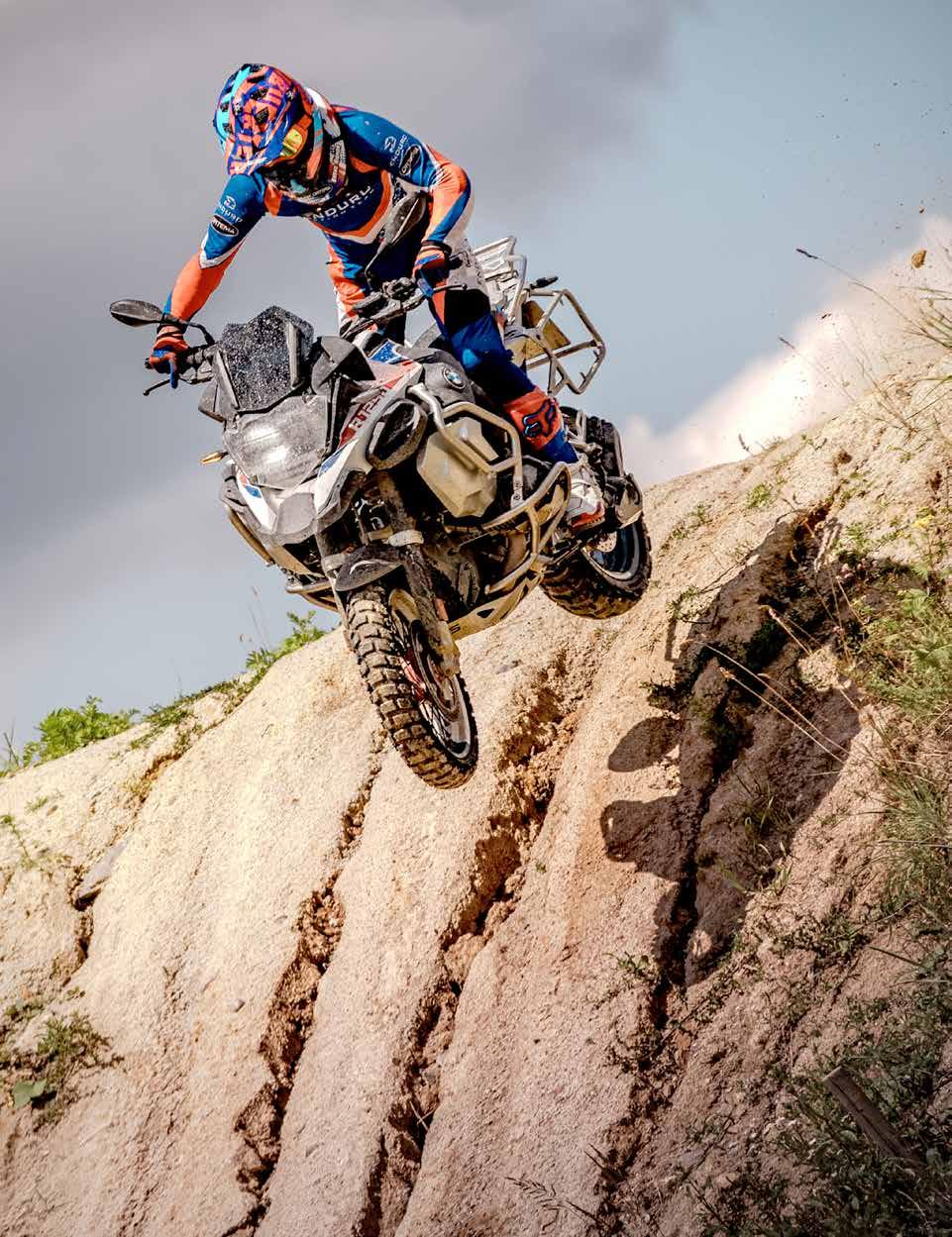

Easy going
My original intention was to hit Gingers Creek for lunch, but a pre-ride phone call to Gary let me know the place was, unfortunately, closed (thankfully it’ll be reopening soon). I took advantage of fuel and a well-stocked bakery at Gloucester before heading out through Bundook, along Tiri Road across the Manning River – where the water level was much higher than usual – onto Nowendoc Road, past Rock Crossing and on to Cells Road for a short blast.
Kerriki Forest Road offered a sensational view as I rounded the first corner and the track was good. There were a few ruts to ensure concentration was kept at a high level, and then it was on to Knodingbul Road, past Dingo Tops campsite, the second entry to Blue Mountain Creek Road, Cells Jeep Trail and on to Eagle Hawk Trail.
I’d done Eagle Hawk Trail several times.
It descends steeply to the Cells River, which is usually easy to cross – although
I was a little worried following recent rain – then a moderate climb meets Cells River Road, giving the option of joining the Oxley Highway or heading back to Nowendoc Road.
Straight away it was obvious the track hadn’t been used in a while. There were plenty of branches to navigate around and a moderate descent kept me focused. That was followed by a seriously steep and rough descent which had me thinking, ‘I hope I don’t have to come back this way’. The track levelled out before a slight climb and the final drop to the river. The surface was 100-per-cent clay with zero traction.
I tried several times but couldn’t progress. I just kept getting flung into the bush.
I decided to backtrack, but while the long climb started well, I wasn’t really in control. The mighty 890 kept climbing and was within 10 metres of the top when I finally had to bail.
No matter what I tried I couldn’t climb any further. It was just too muddy and wet.
A decent rider would’ve gone back down, but it was about a kilometre and I was worried I wouldn’t make it as far on another attempt.
I took the luggage off and carried it to the top, then let tyres down to 10PSI, but it was still no good.
Okay…this time
I walked to the top and got mobile reception, rang Eyebrows for advice, and got an ear blast for not asking him along – although he did offer to jump in the ute to ‘rescue’ me.
It was a hot, sunny afternoon and the hill was facing west, and I could see it was definitely drying. Eventually, after three hours, I managed to get up the middle of the track. I restored the tyres to their correct pressures, and then needed several goes before finally conquering the next section. was very thankful on re-joining Blue Mountain Creek Road.
bolted straight down Knodingbul Road to Bundook then Gloucester, where I arrived in the dark at 6.30pm. From there I cruised down the highway to arrive home at 8.05pm for another ear blasting from She Who Must Be Obeyed.
It was a huge day which begs the question: should we ride the harder tracks alone?





tools in one For further information on this and all our products, please check our website for details. Also available at all good motorcycle shops through Pro Accessories Pliers, rasp, needle insertion tool, knife and 5 pre-glued plugs, all in a handy pouch.


Remove offending item from your tyre. 2 Use the rasp to clean out the hole. 3 Thread needle with plug, push into the hole, twist 1 ½ times before pulling out. 4 Separate the knife from tool and cut the plug flush with the tyre.
The 2022 Ural Adventure Ride was a threeday event held in September, starting and ending at Ural HQ in Uralla, overnighting in Glen Innes and Bellingen. Entry fee was $25. Greg Jansen led the ride and had a ball.
Words and images: Greg Jansen

It’s hard to put into words the feeling of riding country roads in the middle of nowhere, with no idiots on the road and around every corner something new: scenery, a beasty crossing the road or a derelict building or shearing shed…it’s just magical.
I run a couple of GoPros on the outfit and put together short films and relive my trips that way, but rarely will I write an article on a trip.
I suppose I’d better start telling you about this ride.
Like a shot
Friday morning saw a group of 27 outfits, their passengers, including ‘Jack’, the Jack Russell, gather at Ural Australia HQ for the start of the first day’s ride. Steady rain the previous day and night resulted in some roads out and bridges under, so minor alterations to the beginning of the route were in order.
The starter’s pistol fired and off we went.
Basics
One positive about the rain was it stopping the dust, and despite the dire weather forecast, it held off pretty much all day.
The first river crossing saw maybe just a little more water over the road than desired. I engaged 2WD and headed on in, and all 27 bikes went through without incident.
For the benefit of those who have not had the pleasure, allow me to explain the cornering technique and physics of ‘an outfit’. Riding an outfit over dirt roads is like nothing else. Once you get the hang of drifting into, through and around corners it’s too





much fun. Unlike two wheels, the speeds are slow to moderate, and most travel is done at between 40kph and 80kph. For left corners, hit the apex and throttle out. For right corners, throttle off, apex and gently throttle out.
Let me explain.
The bike is like a brake. Throttle is required on lefthanders so the bike is effectively overtaking the chair. Throttling off on righthanders has the chair is overtaking the bike. Obviously, feeding too much throttle on when in a lefthander will result in the chair leaving the ground (aka ‘flying the chair’), followed by much yelling by the passenger and two sets of very round eyes. Not throttling on through a lefthander generally results in the chair crossing to the wrong side of the road, followed yet again by much yelling and flailing of the fists by the occupant of the chair. Neither of which I would recommend!
Once you get the hang of the basics, applying rear brake on gravel roads in a righthander, sliding the rear around and throttling out, is a joy. Mix that with a bit of flying the chair on lefthand exits and it’s heavenly!
Back to the ride.
Undulating, winding gravel roads through beautiful country, ridden at a relaxed pace, gave time to look around and take it all in. This is ‘the Ural way’, and eventually all stopped for lunch at an abandoned school in the scrub. One of the group had actually attended the
Below: Adventure riding requires
equipment.

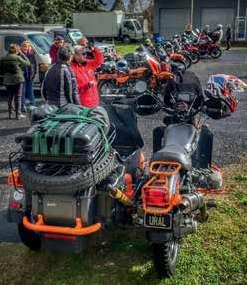
school many, many years before. Sadly, there was nothing left of the old classrooms and it’s now an emergency centre for the SES.
The lunch bell sounded and out came tables, chairs, picnic blankets, charcuterie plates and hot and cold drinks…magic. After lunch it was more of the same, with some brilliant faster sections on sandy-surfaced road. Sand, slippery wet clay, mud, and any of those surfaces that bring fear and loathing to the hearts of mere mortals on two wheels, are welcomed on three wheels. The rider just twists the throttle and goes.
The happy crew carried on to Glen Innes, and after only one incident of following the Fuk-r-we bird everyone arrived safely at the overnight destination just in time for happy hour.
Saturday morning saw a sunny start to the day as the troop took to the back roads of Glen Innes, enjoying more spectacular scenery and plenty of opportunity for regular stops.
Regular stops are also a Ural thing. Rides are relaxed, leave-your-ego-at-the-door affairs. The stops are an opportunity for the orators in the group to tell stories. During such tales it’s not uncommon to hear utterances of, “Get to the point,” or “Is this going to take much longer?”
Saturday’s lunch was enjoyed by the Boyd River and included a dip in the chilly waters by none other than ‘Chilli’, the man himself.
Bottom: One well set-up outfit! u
The afternoon ride meandered along


forest roads and over mountain ranges, with regular stops at some spectacular lookouts where the stories just got better – and thankfully shorter – with each stop. Bellingen was the destination for the second night’s stay, with a few venturing back up the mountain to Dorrigo due to the limited accommodation. We gathered for dinner to share and sometimes repeat stories with much laughter as another great day’s ride was celebrated.
Personalised
Dorrigo was the starting point for the final day’s ride.
It was another sunny day as the Urals headed west, enjoying the many twists and turns of the mountain back roads, and a morning-tea stop at Ebor Falls before continuing on.
A second moment of self-indulgence:
Above: A privilege to have led such a great bunch of people.
Below left: Regular stops are a Ural thing. Rides are relaxed, leave-your-ego-at-the-door affairs.
Below right: Surfaces that bring fear and loathing to the hearts of those on two wheels are welcomed on three wheels. The rider just twists the throttle and goes.
I’m often asked what mods I’ve made to my outfit…
v My latest modification was a set of new shocks. I took the plunge and brought myself a set of 2Win shocks out of France. A ‘set’ on an outfit means buying five shocks! It made a massive, massive difference to the overall ride and handling of the bike. You send your weight, passenger weight, luggage and type of riding you do, and they set

them up at the factory. Mine are pretty spot-on and I’m very happy with them;
v A set of Whites heated grips and my Garmin Zumo GPS. I’ve installed a fuse block with room to plug in six accessories wired to supply power when the ignition is turned on. It’s a very simple to do and a worthwhile modification;
v A Ural adventure windscreen to which I’ve added two supporting brackets to keep it from moving when riding on rough roads;
v A plug-and-play LED light to replace the standard Ural blub in the headlight. It’s still not enough light, so in future I’ll be replacing the HID lights on the front of the chair with a light bar – not that I ride much at night; and
v My passenger would like a rear-view mirror mounted on the chair and a




stick to whack me with when I fly the chair.
Apart from that it’s standard. This is my third Ural and the difference between my first outfit, a CT, and my current outfit, a Sahara, is chalk and cheese. There’s noticeably more torque and everything just feels better. The build quality, tech
and just about all other parts of the outfit have improved. A single exhaust gives better clearance and the 2WD works a treat.
Just on the 2WD, forget about engaging it on hard surfaces, including graded dirt. It’s basically a diff-lock and therefore makes it very hard to steer on
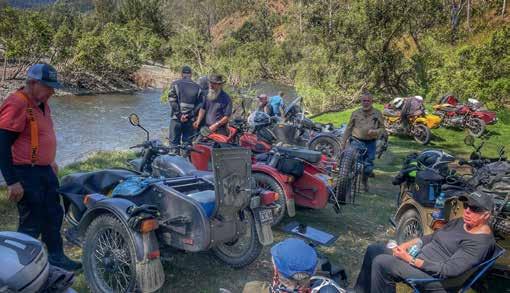
the hard stuff. It’s brilliant in sand, mud and, I’d imagine, snow. It will get the outfit out of and up almost anything. Back to the ride.
A mix of sealed and dirt roads, and of course more creek crossings, was a great way to end the ride.
We’d arrived back in Uralla by 3.00pm, and showered and headed off to the Top Pub for a farewell dinner and a couple of celebratory ales, and of course more stories. After the few days’ practice the stories were shorter and to the point. What a great ride. I felt privileged to have led such a great bunch of people – well-humoured, generous and, most
Above: Saturday’s lunch was by the Boyd River. ‘Chilli’, the man himself, went for a dip in the chilly water.
Left: Out came tables, chairs, picnic blankets, charcuterie plates and hot and cold drinks…magic. Right: It’s just amazing.

importantly, out there riding and enjoying themselves.



A big thank you to Clare and Mat at Ural Australia and everyone else involved in putting on this wonderful event. Plans are already in motion for the 2024 ride.
If this has inspired any of you to give it a crack, Ural Australia put on regular ride days. Give Clare or Mat a ring and they’ll get you on a bike.
One last thing I’d recommend is if you do take the plunge, give Jon Taylor at Ural of OZ a ring and book on one of his great courses. They should be mandatory. I promise you won’t regret it.
Hope to see you on our next adventure ride.




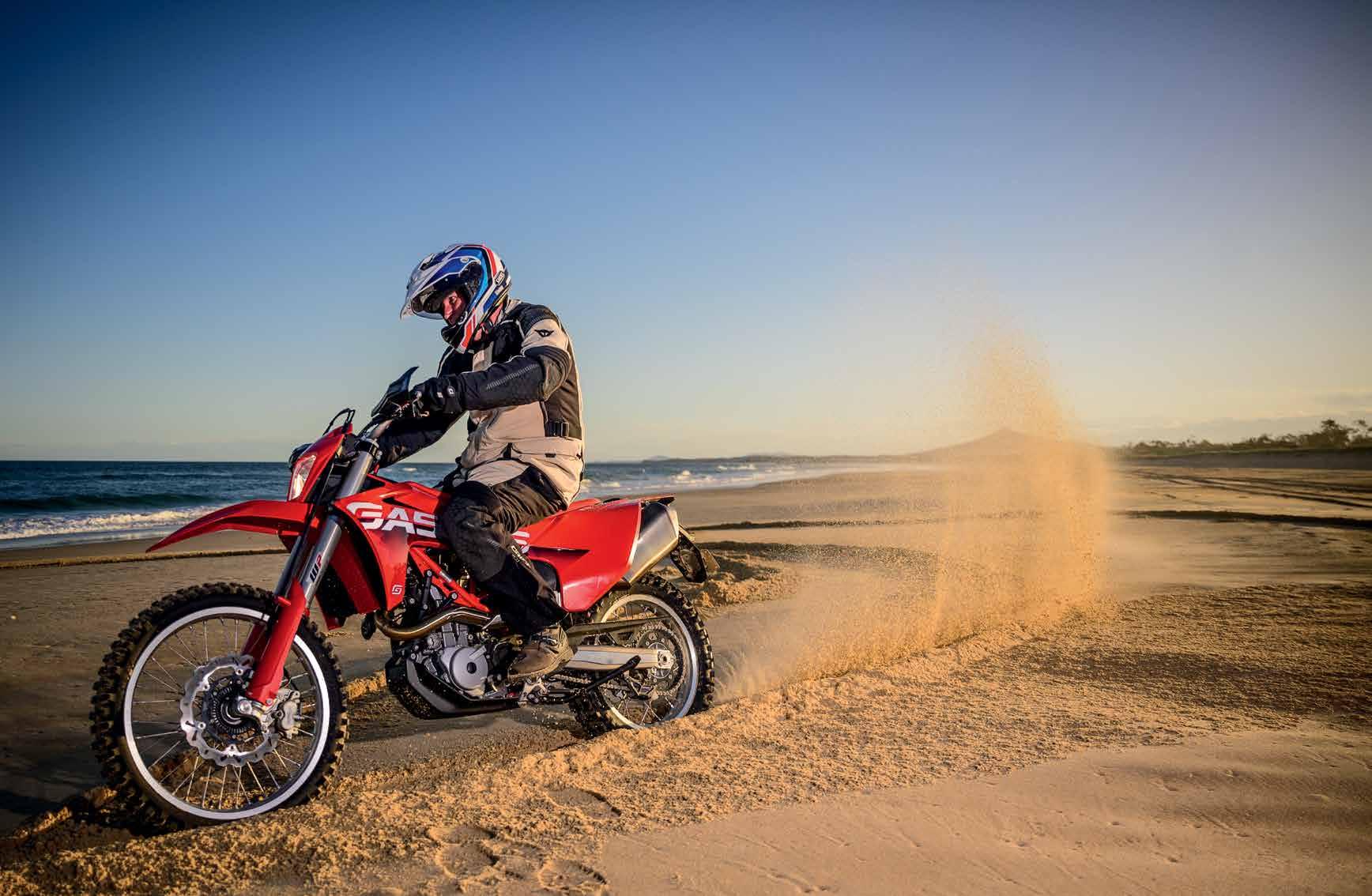
No doubt there’ll be endless discussion on whether the ES700 is a rebadged 690 or 701, and we’re going to be brutally honest, we couldn’t care less. No matter what it’s ancestry or where it was made, this is one fantastic, aggressive, excellent off roader.
That it’s as sexy as Taylor Swift in a see-through outfit under a gentle waterfall doesn’t influence our opinion at all.
Well.
Not too much.
The bike certainly looks and feels a lot like the Husky and KTM, and the numbers on the spec sheet are very similar. If you look back at our
opinions on those bikes, you’ll have a pretty fair idea of how we feel about the GASGAS.
The 692.7cc single-cylinder motor is a snorter. Power delivery is strong but very manageable, and the spread of power is quite surprising.
The action is all in the mid-range and upper mid-range, but we were surprised at what a torquey mutha it was, too. Even the editor could pull wheelies, and not his usual panicky throw-the-front-wheel-in-the-airshit-himself-stab-the-rear-brake wheelies, but beautiful controlled lofting of the wheel that almost made him look competent (almost. It’s a bike, not a magic wand).
The six-speed gearbox is a good’n and features a smooth and usable quickshifter which is almost a waste,
because the hydraulic clutch is a premium unit. It’s not as light as some, but it’s way lighter than many, and the action is progressive and predictable.
A slipper clutch helps keep things sane on hard deceleration.
Suspension is WP front and rear, with 48mm upside-downers sporting compression and rebound adjustment, while the rear is WP with high and low compression-, rebound- and preload adjustment.
Electronics include a couple of modes sensibly called Mode 1 and Mode 2, an amazing traction control which can be changed on the fly, lean-angle traction control, and Quickshift (+) which we’ve already mentioned. u
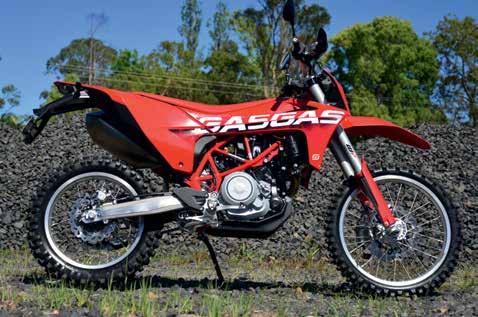
Main: For the sheer joy of pushing hard and tackling difficult terrain, the GASGAS ES700 will be hard to beat. Above: What is it about red that’s so incredibly sexy?

Tall order
The 935mm seat will be a worry for plenty of riders weighing up the bike’s suitability, and along with a ground clearance of 269mm is an early indicator of the designers’ intentions, we figured.
As we’ve seen on other bikes like this one, the tank does double duty as the rear subframe, and the fuel cap is behind the seat, pretty much right where the luggage or a rack will go. It’ll mean packing with some forethought to avoid having to unload everything at the bowser, but plenty of owners have sorted the situation over several years now on the other brands, so it’s obviously not a major problem.
As a humorous side story, the cable loop which releases the seat is in the space under the fuel cap. When it was time to do the detail pics there was a great deal of swearing and bellowing when that little loop couldn’t be found. We tried feeling round behind the sidecovers, turning the key in different directions, damn near ripping the seat off by main force and even dropping to our knees, whimpering, and begging the bike to let the seat go. It wasn’t until we got to the servo the conundrum was resolved.
Above: A fantastic bike, a summer day and a deserted beach. Does it get much better than this?
“ There’s a stack of OEM accessories available for the bike, but a rack or panniers aren’t part of the line up. ”
The tyres on our review bike were Pirelli MT21s and there was also a pair of KTM folding mirrors which we liked a lot. We’ve been using those mirrors on lots of bikes for years. Pillion ’pegs will apparently be supplied with the bike, but weren’t fitted to our review unit. That suited us fine. Like all bikes these days, there’s a whopping muffler and cat converter, but the whole stainless-steel exhaust was tucked in tight and didn’t cause us any concerns. It was very quiet, but still had a nice throaty chuckle and a pleasant
induction growl, and we couldn’t help but wonder how power delivery would be affected if the whole system were swapped for something which breathed a little more freely. We’ve learned the lesson that, no matter what the knowledgeable internet experts may say, removing the cat doesn’t always give performance gains. But still, the motor is so frigging good, we’d be very keen to try one in race trim, just to see what it was like.
Our only real head-scratcher with the GASGAS was the lack of anywhere to carry or secure luggage. There’s no rear frame rails, a rack, or even space around the rear guard to attach Andy Strapz or a length of rope, and we ended up with a brutally heavy backpack with tubes, tools, Vaseline and other essentials.
Maybe if we’d thought of it we could’ve bolted on the pillion ’pegs. That may have presented some possibilities.
Accessories
There’s a stack of OEM accessories available for the bike, but a rack or panniers aren’t part of the line up, and that might give potential owners some pause for thought. In fact there’s some excellent aftermarket equipment

Above: The hydraulic clutch is smooth and progressive. It almost makes the quickshifter redundant, but not quite. Until the quickshifter was pushed hard in the deep sand, it worked a treat.
Top right: Mirrors secure the perches on the rider’s side of the ’bars. Nothing special about that. We just found it interesting. The mode and traction-control buttons allow changing on the fly.
Below: The harder the bike is pushed, the better it performs.


available from several good companies that will allow loading up the bike safely and securely, but the OEM list centres around a number-plate support, slip-on silencer, ergo seat, skidplate, crash bars and a few other bits and pieces. There’s also apparel of course. Have a look at the website for a full rundown (for the supermoto brigade there’s a set of leathers that’s dead sexy!).
Riding the GASGAS is an absolute joy. It definitely deserves the title of ‘dualsporter’, but it’s way over on the off-road end of the dualsport scale. It’s slim, aggressive, turns, rails berms and carves ruts in a manner not too far removed from a thoroughbred enduro bike, but holds its own on the road. Actually, in performance terms it more than holds its own on the road.
Dear lord. It still staggers us bikes with this kind of performance are available straight off showroom floors. Even with the dirt-oriented tyres we found ourselves moving further and further into licencedestroying territory on the 700. We can only try not to wet ourselves at the thought of the supermoto version and a closed track somewhere.
But it was in a challenging off-road scenario the bike really came to life.
When the GASGAS hit the dirt it was immediately obvious where the bike belonged.
We did a 400km day of bitumen and found the lack of a screen and having to carry luggage less than ideal, but the Gasser was surprisingly comfortable otherwise. It also gobbled up the distance as though it was insulted at being given such an easy task. Sitting on freeway speeds was too easy, squirting up to overtaking velocity was fun, and the riding on a beautiful sunny day was very bloody enjoyable.

The motor has a surprising spread of power and resisted stalling right down to seemingly impossibly low revs, and if the throttle was held open in a panic to try and scramble up a loose, shitty hill which suddenly steepened up around a switchback corner, it answered the call. Every time.
u

The seat is fairly flat and stretches right up to near the steering head, and good riders will be in ecstasy at how well the thing handles when it’s ridden like a motocrosser. Braking late with the rider’s weight back, hitting the apex while throwing the rider’s weight forward and cracking open the throttle is heavenly. Picking a line through rough, rocky terrain is hardly any strain at all, and hoiking up the naked bike after intentions outrun talent is a thankfully achievable task, even for fat old editors swearing at photographers for making them ride in the sand.
The modes, switchable on the fly using a button on the left-hand side of the ’bars, were all we figured riders would really use. One was a tad punchier than the other, and the ABS tuned to match – sorry, we can’t remember which was which. Ask a dealer – and as far as we’re concerned, two modes is plenty.


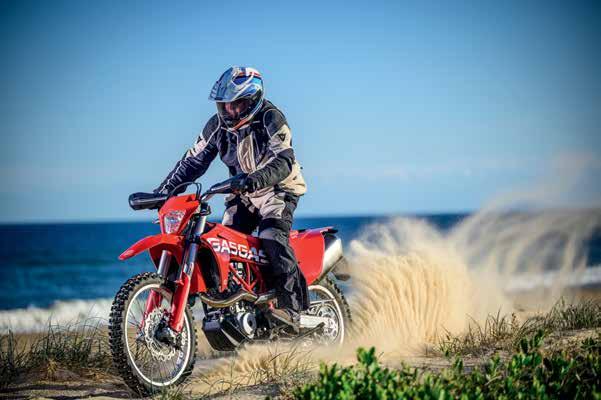
The ABS was aggressive and we really liked it as it worked in each mode. We didn’t have any need to adjust it.
The traction control was very interesting. Because the photographer – frigging Wilko! – wanted to do ‘skids and wheelies’ on the beach, we ended riding deep sand for an afternoon, and like the ‘slip’ feature on the KTM and Husky traction control, the system doesn’t automatically start juddering and cutting power. It keeps the bike moving and the wheel turning, and that means the rider stays upright and, even if it’s not elegant, can maintain some level of control.
The media info says the traction control is adjustable, but once Wilko showed us how to turn it off, we were happy and didn’t come back to mess with it.
Sorry about that.
We did do more than enough riding with the traction control on to be very impressed it…as we were with the whole bike.
The GASGAS is a bike which will suit riders who like to spend time off road, and like an aggressive riding style.
It’s more than capable as a longdistance bike, but it’s not where the ES700 shines. It comes into its own when the terrain’s tough, the rider’s even tougher, and, best of all, if someone throws out a challenge.
Anyone who does throw out a challenge better be ready. If the Gasser is in the hands of a capable rider, the challenger is likely to end up with a face the colour of this exceptional bike.

s Recommended price: $17,695 ($19,295 ride away). Web: gasgas.com
Engine type: Single-cylinder, four-stroke
Displacement: 692.7cc
Bore x stroke: 105mm x 80mm
Power: 74hp (125 kW) @ 8000rpm
Compression ratio: 12.7:1
Torque: 73.5Nm @ 6500rpm
Starter/battery: Electric starter/12V 8.6Ah
Transmission: Six-speed
Fuel system: Keihin EFI (throttle body 50mm)

Control: 4V/OHC with intake cam levers and exhaust rocker arm
Lubrication: Pressure lubrication with two oil pumps
Engine oil: Motorex, Power Synth SAE 10W-50
Final drive: 15:46
Cooling: Liquid cooling
Clutch: APTC slipper clutch, hydraulically operated
Engine management/ignition: Keihin EMS with RBW, double ignition
Traction control: MTC (2-mode, disengageable)
Frame: Chromium-Molybdenum-Steel trellis frame, powder coated
Subframe: Self-supporting polyamide tank
Handlebar: Aluminium, tapered, Ø28mm/22mm
Front suspension: WP XPLOR-USD Ø48mm
Adjustability: Compression and rebound
Rear suspension: WP XPLOR-Monoshock with linkage
Adjustability: Compression (high and low), rebound, and preload
Suspension travel front/rear: 250mm/250mm
Front brake: Brembo two-piston, floating caliper, brake disc Ø300mm
Rear brake: Brembo single-piston, floating caliper, brake disc Ø240mm
ABS: Bosch 9.1 MP (Cornering-ABS, disenengageable)
Wheels front/rear: Spoked wheels with aluminium rims, 1.85 x 21”” 2.50 x 18”
Tyres front/rear: 90/90-21”; 140/80-18”
Chain: X-Ring 520 5/8 x ¼”
Silencer: Stainless steel silencer with regulated catalytic converter
Steering-head angle: 62.3°
Triple-clamp offset: 24mm (2 mm)
Trail: 120mm
Ground clearance: 269mm
Dry weight (approx): 147.5kg
Seat height: 935mm
Wheelbase: 1506mm +/-15mm
Fuel-tank capacity (approx): 13.5 litres
CO2 emissions: 99g/km



Main: The author contemplating the state of the world before an unexpected three-course meal and a shearer’s bunk.
Insert: Riders weave around pavement walkers between other motorbikes, scooters and pushbikes.
Riding in Asia is almost incomprehensible unless you’ve seen it first-hand. Destinations like Vietnam and Thailand can be some of the most hazardous places on Earth as 50cc screamers dart every which way. And because high-traffic roads are so crowded and narrow, riders weave around pavement walkers between other motorbikes, scooters and pushbikes.
It’s almost incomprehensible for Australians. And that’s without considering the changeable weather: humid, sweltering heat, monsoon rain and anything in between.
I was considering this state of affairs as I darted from one location to the next, hoping to find somewhere in our own country which wasn’t in danger of being submerged during a cycle of extreme rain events.
In Australia bikes are seen quite differently in terms of application and configuration to places like Asia.
In many of those countries, generally, if you want to get to work, you walk, catch any number of overloaded, rust-ridden buses, or become a passenger on some sort of wheeled contraption. If you have the necessary cash you can ride a scooter, or, better still, a small-capacity motorcycle.
As for Aussie billboards scolding us to wear protective boots, helmet and gloves…I think not. In Asia it’s mostly thongs, a T-shirt, or maybe a short-sleeved shirt, with more than likely a passenger or two on board or cargo that, in both scale and tie-down method, beggars belief.
In such places the ’bike or scooter isn’t a vehicle for adventure –although riding in that setting certainly presents as a challenge. Cities like Phnom Penh can be very frightening to the uninitiated. This was a crazy juxtaposition of thoughts flashing through my mind as record rainfalls smashed down on my own home region. I’d packed to ride somewhere – anywhere – in search of blue sky.
I’d headed away from the southern coast. I didn’t pay a lot of attention to the route and was content as long as I was heading toward Victoria’s wide-open sunset country in the State’s northwest.
Even so, as my initially aimless ride gathered momentum my mind was a-buzz, and I found myself reliving the noisiness of those high-population situations. Just about anyone and everyone rode to get from point A to point B, jamming roads and eateries so tightly that if one toppled there was every chance one might not fall over – rather one’s bike and self would simply press into other bikes jammed within the same space. It was hardly understandable compared to even the busiest of Australia’s urban spaces, let alone wherever I was headed. It wasn’t the crush in those hectic places or their heavily populated rural counterparts wanted to write about. It’s our freedom, and the ease with which we are able, by contrast, to snatch time and escape. In my case, to try and escape the rain and maybe luck upon a place under blue skies and not wallow in a sodden landscape – and also hopefully be without lunatic motorists who appear to be firmly of the belief wet tarmac is a 100-per-cent positive braking surface. Or encounters where either feathered types, goats, pigs or – heaven forbid – camels make their way onto the road.
u
All clear Thankfully, once out in the sticks my riding was lazy and devoid of assertiveness. My direction was unencumbered by the hazards of the more crowded places conjured up by my wandering mind.
began to consider how Russia’s brutal war with Ukraine had impacted supplies of wheat, barley, corn and vegetable oil to the world and exposed some harsh truths about Europe’s reliance on gas, especially when the sun’s not shining. Add the reported catastrophic failure of Sri Lanka’s organic farming that has brought a once agriculturally self-sufficient country to its knees, and there’s no doubt things certainly aren’t what they once were. They’re realities I frankly struggle to process, and make the challenges of adventure riding seem inconsequential. pondered on this as another blurred directional change had me crabbing more northerly than westerly from my rain-soaked and windswept start. My ride had become more of a chase through the Garibaldis south of a bleak Ballarat, tracking westerly via Mena Park, Raglan, Mt Buangor and Jullukar, before catching some spectacular views from the serpentine Balconies run that splits the northern Grampians.
Free
By mid-afternoon my chase for sunshine had morphed into more throttleopening bends, straights, curves and crests to reveal more vividly painted landscapes. The colour ramped up dramatically as the time and distance wandered on, and a brighter blueness had thankfully become visible through the grey cloud. The countryside flattened and gave way to wire-fenced laneways typically the playground of rural types in battle- scarred utes.
Having commenced without any goal other than to find and ride beneath warmer, clear sky, there was a total absence of urgency. The bike rattled across another rail-line and I twisted on a little more throttle, thrilling in the feel of the rear wriggling on the gravel, until a thin strip of bitumen presented itself. My arse, legs and hands transmitted the changing feel of each surface until again I decided to stop, remove my helmet and gloves, and feel the chilly afternoon’s breeze on my skin.



A quick 30-or-so unsealed kilometres.
Top: Gotta love a rural sunset.
The spectacular view from the Balconies run that splits the northern Grampians.
Well met
Another rural settlement’s peaceful streetscape unfolded under what was by then an almost cloudless sky. Another day’s end wasn’t far off and it was time to pull up.
My stopping-off point was flanked by what looked like old business premises, including a once-upon-atime general store which now looked to be more of a country café. A lone agricultural-supplies depot seemed typical of bygone times.
Another battle-weary ute, its tray a scatter of long-handled shovels, fencing wire, steel fence-post droppers and a battered tin box caught my attention. What I assumed was one of the vehicle’s owners, as if in slow motion, rose from the group on the veranda and looked my way.
He was a hardy type, relaxed, sunbleached, and flashing a welcoming smile. With a sort of unspoken understanding we laughed at each other’s chosen mode of transport.
He was first out of the blocks, “Can we shout you a drink?”
The welcome couldn’t have been timed more perfectly.
The day’s end wasn’t far off and my bluesky chase was done.
We shook hands and together rejoined his mates, a group of contractors who’d banded together to help another’s neighbour. Such is the unspoken brotherhood of rural Australians. The moment and time couldn’t have been more fortunate. We clicked, so I saddled up for a quick 30-or-so unsealed kilometres to their friend’s property and an unexpected threecourse dinner invitation. My overnight stay at the property’s shearer’s quarters underlined how unencumbered my ride had been, particularly in light of all my earlier flickering’s about other realities.
I battle to process in short my insignificant chase of rainlessness. Compared to some other people’s reliance on their two-wheeled transport to help them eke out a better life, I realised my wandering thoughts meant my adventure had become about a great deal more than I could have imagined.
A year on, there’s still part of Andrea Box that can’t believe she crossed the Simpson Desert.


The Simpson Desert worms its way under your skin, and memories of outback adventures keep calling you back for more.
The dream behind this trip really started two decades earlier, and I’d quietly entertained the idea on and off over that time. So much doubt lingered, even after years of riding I still wondered if I really had what it took to ride across Munga-Thirri – the Simpson Desert.
Honestly, I thought it would just remain a bucket-list trip as it has done for so many Australian adventurers.
The challenge
The world’s largest parallel-dune desert has a unique appeal. Its 1100 dunes packed densely into just over 200km, and a rich history had drawn adventurers since the first recorded crossing by camels over 80 years ago. The biggest dune, ‘Big Red’, on the most easterly side of the desert, was named with a distinct lack of imagination. It almost seems to have a personality of its own, and for travellers taking on the desert east to west, Big Red is the first dune to tackle, catapulting you down its steep western
slope and straight into the deeper, soft Simpson sand. The view from the top only hints at the task ahead as sand dunes, one after another, disappear into the horizon.
Being confined in Melbourne as a healthcare worker for lockdown was a tipping point.
Life was too short for doubts and fear wasn’t doing me any favours, so I tentatively started a conversation about attempting the ride. Having crossed the Simpson five times, my dad, Robin, was the sounding board. I knew he’d tell me honestly if he didn’t think I was up for the challenge.
Before I knew it, it felt like I’d pushed a boulder down a hill, and it’d gained too much momentum for me to stop it even if I wanted to – which think was exactly what I needed. It wasn’t my choice at that stage. It was happening and there was no turning back.
My sister Lisa was swept along in the momentum, and despite some nerves and hesitation, she didn’t want to miss the chance for us to attempt a Simpson crossing together.
When Lisa and I were eight and 12 we’d done the same trip in a support vehicle as our dad and 11 other riders made the crossing. Along with us were aunts, uncles, our nana, new friends and old friends, all joined by a desire to see the desert. To say the vast beauty of the terrain, the camaraderie of the group, and the adventure as a whole left an impression on us would be an understatement. More than just that, it planted a seed in our young minds: one day, just maybe, we might be able to do that too.
As the enthusiasm of the planning grew it gathered more people along with it, and by the time we met up for our first planning meeting in northeast Victoria there were 14 of us. Four bikes were ridden by Lisa, family-friend Mick, our cousin Wayne, and myself. In the four 4WDs were our father Robin, family
Eric and Janine, and his son Cooper.
This wasn’t a hard-core unsupported ride, or a typical desert ’bike crew, and I was thrilled we had a team spanning three generations. The group came about as like-minded people showed interest in the adventure, and watching the kids discover the desert for the first time brought a whole different sense of wonderment to the trip.
The preparation was shared through the group. Those mechanically minded prepared the vehicles and bikes while others focused on the itinerary and catering. Knowing organising a big group can lead to confusion, everything was chatted about in the early meetings so we were all on the same page. With Lisa being a teacher and me a trauma nurse, we played to our strengths and organised everything down to the last packet of dehydrated peas. Google Docs and Excel were our best friends, tubs were labelled so anyone could easily find anything, and there was a recipe for each meal to make sure everyone could pitch in.
With the crew spread across Victoria, COVID restrictions kept changing and it looked like the whole thing might have to be called off. But at the eleventh hour the ring of steel around Melbourne opened and the last of us were allowed out of the city.
Jumping through hoops for permits and getting COVID tests at border crossings didn’t faze us. We were just thrilled the trip was going ahead.
We got into South Australia in the nick of time as the border closed the day after we crossed.
Having worn a mask for eight hours a day at work for the previous two years, having the fruit-fly border control welcome us to SA and tell us we could remove our masks made us all laugh.
As we unloaded the bikes at Leigh Creek the adventure started in that we encountered our first problem. Mark and Debbie, who had arrived two days earlier, had broken a rear-axle diff on their 4WD. Mark had a spare in his garage in Victoria, so we’d brought it with us in an extra vehicle that would be left at Leigh Creek.
Trouble never arrives alone, and a Kangaroo jumped into the side of the spare vehicle just before Mildura.
Hoping we’d got our bad luck over and done with, the crew rolled up its sleeves and changed the diff in the pub carpark while the rest of us rearranged the supply tubs and food between the 4WDs and prepared to leave the next morning.
Kicking off with some faster kilometres on open outback roads, we headed up the Strzelecki Track towards Cameron Corner, Innaminka, The Dig Tree, Cordillo Downs, and on to Birdsville. We reminisced along the way about how things differed from our nearly 20-year-old memories and yet felt

exactly the same. After a particularly wet season it was so much greener than we knew the desert could be.
After being in Birdsville with the hordes of people headed to the Big Red Bash, it was a relief to set up our tents alone at Poeppel Corner. As dusk settled and the evening sky put on a show for our first night in the Simpson we strolled down the boardwalk to the survey marker. For some it was to see it for the first time, and for others it was to recreate photos taken 20 years earlier.
As so many do in the desert, we all carried UHF radios to stay in touch with each other and other travellers.
As the kilometres passed the team quickly fell into a rhythm. Wayne, an experienced high-country rider, led and blipped his radio to warn us of oncoming vehicles. Lisa followed on a lowered DRZ400. As the newest rider she had the choice of the packed wheel tracks.
I was next, also on a DRZ400 – watching my sister take on the sand was such a wonderful thing to share with her – and the ever-calm Mick brought up the tail end on his rebuilt XR650. With its kickstart and his classic ’70s and ’80s music blaring in his helmet you’d almost think he was out for a Sunday ride.
The days in the dunes tested our fitness. We were glad we’d done sand training in Rainbow, Victoria, and been in the gym squatting till our legs shook. But there’s little that truly compares to long days of sand riding. We were told by many

seasoned sand riders that it gets easier on the third day, which it did, ironically right as the dunes finished.
The company
The desert threw plenty of challenges at us, and not just the terrain. Wayne’s CRF450 was giving trouble and needed to be jumpstarted or tow started each time he stopped. It quickly went from his reliable ‘Little Buddy’ to being frustratedly called ‘You Bastard’. By the end of the trip he had rediscovered some love for his not-sofaithful steed seeing as it carried him across the desert.
To keep together as a group the riders
rode an hour at a time before waiting for the 4WDs to catch up. While we enjoyed cruising along the clay pans between the dunes as if they were single trails, the 4WDs not so much, as they got rocked and rolled all day long. I honestly couldn’t have imagined a more wonderful group to travel with. Conversation never seemed to run out, the jokes were endless and the camaraderie of the team added so much to the adventure. Evenings as a group soon ran like a well-oiled machine, words were minimal and everyone knew what needed to be done. With music playing, lights were strung, tents set up, the kitchen was assembled and young and

old chipped in. Ava and Cooper were self-appointed makers of our evening ‘fancy’ cheese platter of Arnott’s Savoys, homemade salami and plastic cheese. Mornings saw the first person up in charge of boiling water for coffees. We gradually emerged from our tents to stand around the fire until the caffeine kicked in, then it was time to put our boots back on and tape our blistered hands. A flurry of movement around the camp would see the vehicles reloaded and tied down, Camelbaks filled, and evidence of our camp reduced to just footprints.
The bikes found a great spot for our last night in the desert as we picked the perfect clay pan to pitch our tents.
In the time before the 4WDs caught up we perched ourselves on the top of a dune surrounded by wildflowers, desert finches, and lizard tracks and chatted quietly before settling into companionable silence to take in the vast expanse we had crossed.
Heading out of the desert and toward

Dalhousie Springs, Bryce and Dan brought up the tail end of the convoy and tested the limits of the Isuzu D-Max, doing 120km after the fuel light came on. They made it to camp looking surprisingly unperturbed, trusting someone would’ve come back for them eventually if they’d run out.
The crew waiting, not knowing why they were delayed, were not quite so relaxed.
The wind whips up the western sides of the dunes creating a gentler western approach, and the sand that blows over the top makes the eastern faces steeper and sharper, so many people choose to cross the French Line west to east. We considered this, but the lure of Dalhousie Springs and a swim at the end of the sweaty days of sand dunes made us decide on east to west. We didn’t regret the decision! As we dismounted our bikes, stripped off our stinky bike gear and popped the bottle of bubbles which had been carefully carried over all 1100 dunes, we headed for the hot springs. After five minutes of floating in the blissful bath-temperature water with the little
fish nipping at our toes, a group decision was made: we would use one of the emergency days we had allowed in our planning to stay an extra night at this oasis.
The conclusion
Thinking back to those desert sunsets I remember our last night in the Simpson.
As we set up camp for the night I watched 12- and 11-year-old Ava and Cooper dodge between spinifex bushes as they scrambled up the red dunes.
I realised we’d come full circle: the next generation was falling in love with the desert and adventure just as we had.
The same way the grains of red sand find their way into every nook and cranny of camping gear and reappear for years afterwards; the Simpson Desert worms its way under your skin, and memories of outback adventures keep calling you back for more. Countless riders have crossed before us and many more will after, but that does little to diminish its beauty and the achievement: we’d crossed the Simpson Desert.
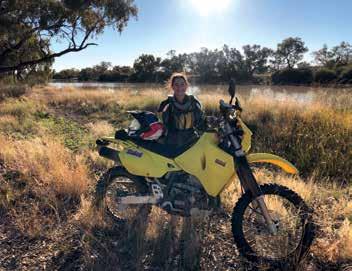



Top: Lisa and her lowered DRZ400.
Above and below: Wayne’s CRF450 was giving trouble and needed to be jumpstarted or tow started each time he stopped. It quickly went from his reliable ‘Little Buddy’ to being frustratedly called ‘You Bastard’.
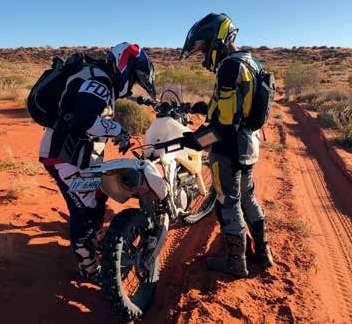

We met Craig Baldwin in issue #52. His journey with his bike, ‘Kramer’, continues. Words and images Craig Baldwin


Ididn’t know it was R U OK day when I set out on this trip. A good friend reached out to check in halfway through my first day, and that was when I realised. It was quite fitting, or maybe it was fate, I chose to ride out on that day, as the past four years had been rather tumultuous for me and my mental-health battle. This trip was a short getaway after I’d discharged from the Australian Defence Force after a 20-year career. It’s my time: my time to move on; my time to regain a level of happiness; and my time to regain my spark.
For this trip I’d mapped out a two-week journey to take in parts of outback Queensland but had to reduce the length of the trip for personal reasons.
My original plan was to head out to Charleville and loop back around to explore Carnarvon Gorge for a few days, but with the shortened trip I decided to leave Charleville for another day. I thought I’d spend a few days hiking through the gorge before returning home. It seemed fitting the first day’s trip was filled with pouring rain. All my trips so far had started out and finished up in the rain. Thankfully it was meant to be fine for the few days I planned spend at Carnarvon Gorge Itself. Most of the first day was spent on some long stretches of rather boring highway, but there were glimpses of beauty and some awesome
Left: Change of plan: head straight to Carnarvon Gorge. Left insert: After 20 years of military service, author Craig Baldwin’s out to regain his spark. Below: A cute lizard needed some help crossing the road. u


wildlife along the way. From a myriad of galahs and cockatoos to a soaring wedgetail eagle in flight banking about 10 metres in front of my bike before flying off, the scenes were amazing. There were crazy and unpredictable kangaroos that always seemed to head towards the bike and a cute little lizard that needed some help crossing the road.
I’d originally planned to camp the first night around Yuleba, but as I got closer to the destination the clouds became darker and finally unleashed a deluge. I was forced to change plans on the fly and made my way into Roma, where I booked myself into a cabin for the night so I could dry out. was doubtful of a clear run the next


day as the pouring rain and thunderstorms continued into the early morning, but as I rose after a stormy night I was surprised to see the sun was out and there weren’t very many clouds in the sky.
It was a stark difference to the day before, so I quickly packed up and got on the bike.
The initial plan was to ride out through Arcadia Valley to Rolleston and drop back down into the campgrounds at Carnarvon Gorge, but it wasn’t long after setting off I noticed field after field full of water, and the few times I pulled off to the side of the road to get some photos I was met with ankle-deep mud. I decided to abort my ride through the valley and just head straight into Carnarvon Gorge. Arcadia Valley could wait until I was on my way home.

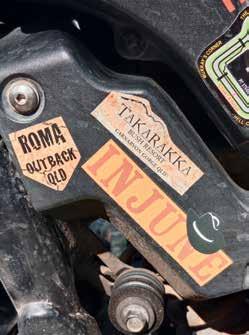
The ride into Carnarvon was just stunning. The mountainous backdrop overlooked the field of crops and cows as the road snaked its way down into the campground.
There are a number of campgrounds and sites dotted along the approach to the gorge, and I found my campsite – Breeze Holiday Park/Takaranka Bush Resort – about four kilometres from the start of the gorge.
Once I’d set up my tent I went to move my bike and made the rookie mistake of

off to bed before what was expected to be a big day traversing the gorge.
not putting down the sidestand. Down came my Yamaha Tenere XT660Z, ‘Kramer’. It was slightly embarrassing with a campground full of onlookers, but thankfully, there was no shortage of people willing to help.
got talking to one of my helpers who was camped next to me and noticed shoes and socks laid out in the sun along a log. I figured they were just airing out some smelly socks, but I learned the next day there was more to it than that.
It was time for a drink, some dinner, and
By the end of the third day I was sore from head to toe, hobbling slightly and had a number of aches, but had a heart filled with joy and amazement and a head full of experiences and wonderment.
At the end of what was a 25km trek spanning the best part of seven hours I’d had the pleasure of seeing some of Mother Nature at her absolute finest.
It was at the very beginning of the track
I knew it was going to be a long and wet day. The recent rain meant the river that ran through the gorge had risen and was flowing rapidly in a lot of areas. The first crossing was literally the start of the
main trail, so for the best part of the day it meant: shoes and socks off; wade across; shoes and socks back on. This was when I realised why my camp neighbours had their footwear on the log back at camp. They weren’t airing them out. They were drying them out. All up on the trek out and back I had to cross a total of 28 rivers. Thankfully the deepest was only around knee height, but to be honest, it did get a bit tedious in the end. It was just a good thing the absolutely stunning stop offs along the main trail made up for it, and made up for it in a big way. One stop was aptly called The Amphitheatre, and had a steep ladder climb up the side of the rock wall to get into it. One thing that struck me instantly, apart from the sheer size, was
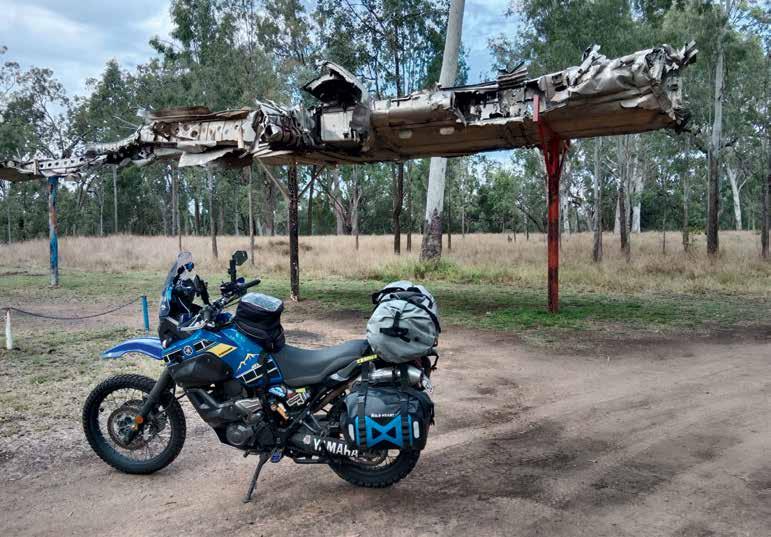
how deadly silent it was once inside. There were no sounds of birds, no sounds of the flowing stream, nothing but absolute silence.
Well…until a blowfly started buzzing around.
The Aboriginal art gallery was the next stop, and that site was like nothing I’d experienced before. The history and the
storytelling generations had etched upon the walls sent my imagination running wild, but the one chilling depiction that caught my eye was one showing interactions with the settlers and a rifle.
The net-like paintings were an indication of a death in the tribe and it was all too sad to see the most net paintings coincided next to the rifle painting.


On
Bottom far left: The trek out and back crossed 28 rivers.
Bottom left: Kramer made a friend.
Above: A campsite about four kilometres from the start of Carnarvon Gorge.
Right: The Amphitheatre had a steep ladder climb up the side of the rock wall.
Bottom right: Mother Nature at her finest.
Navigating the track back to the starting point gave me plenty of time to reflect on everything I’d just seen. It also allowed me to enjoy the same trail, but from the opposite perspective, ensuring I had both sides of the experience. I can guarantee it was one day, one experience, and one adventure that will live with me for a very long time.

From there it was quite a hike and multiple river crossings to arrive at the cathedral cave with many more rock paintings up on the walls, before then diving into the Boowinda Gorge where rockhopping was the order of the day.
Traversing the tall yet thin canal meant I experienced yet again the jaw-dropping beauty of Mother Nature at her best.

What does one do after such an epic day?
Have a rest day, of course. And by that I mean, do two more hikes.
Okay, so you might be thinking that doesn’t sound much like a rest day, but the two hikes were very small walks quite close to the campground.
After a bit of a sleep in I was in no hurry to get out and do anything, so I took my time to get up, have breakfast, and just generally fumble around camp for a while.
One of the walks nearby was called the Rock Pool Hike. It was a short stroll some 300m off the main road, so I headed out for a look.
was met with another water crossing to get to the main rock pool, but as I still had my motorcycle pants and boots on, I wasn’t too worried about my feet getting wet, and in I went.
When I got to the other side, I met a fellow hiker who made mention he’d spotted some platypus in the main rock pool.
Having never seen one in the wild I was pretty excited to catch a glimpse, so I found a grassy patch on the banks and sat and waited. To my surprise, within a matter of minutes, one popped up right in front of me about three metres away. It didn’t stay on top of the water for long, but I’d finally caught a glimpse of one in the wild.
This small glimpse then set the scene for the next little while, where I found a nice high spot on some rocks and just sat and watched the rock pool, hoping for another sighting, no matter how brief.
u
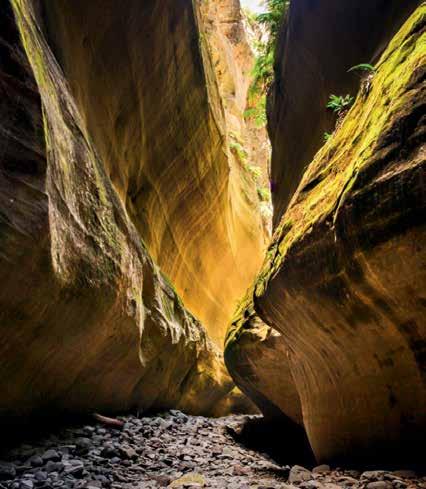

I didn’t get to see another platypus, but this did allow me to stop and take in everything around me, which I found quite calming.
After about an hour I decided to make my way back to camp for some lunch and just took it easy.
There was one more short track – The Mickey Creek Gorge – I wanted to take a
look at, so after lunch I rode back and set out on the walk.
I was completely blown away by the beauty within the gorge. The dedicated path only lasted a few-hundred metres before it turned into a choose-your-own adventure scene of rockhopping and gorge crawling, but this only added to the adventure and scenery. The green mosses on the rock were so vivid, and again the silence within the gorge was very calming.

Left: An amazing sunset over the Chinchilla weir. Bottom left: A bit of bike manoeuvring and some careful placement of a tarp created a nice little windbreak.
I would also go as far as to say this walk was equally, if not even better, than some of those in the more popular Carnarvon Gorge. If you’re in the area, this is a must-see hike, and one that is fairly easy and fairly short compared to the main gorge.
After the two stunning experiences I spent the rest of the day relaxing around camp with a few drinks and snacks which topped off a fantastic couple of days.
After a few days hiking around the absolutely stunning Carnarvon Gorge it was sadly time to pack up and make tracks, although there was one more overnight stop before finally reaching home.
I’d originally planned to stay the last night a Judds Lagoon, just outside of Yuleba, which was also the original campsite I’d planned for the first night, but thanks to the rain I’d made a change on the fly.
Well, again on the way home, I made a change of plans. I reached Yuleba fairly early in the day and decided to push on through to Chinchilla, where I found a nice little free camp at the Chinchilla weir. It was a nice spot with obvious waterfront views. There were a number of caravans pulled in for the night, but I managed to find a quiet patch away from the main van sites.
Not long after setting up the wind increased a little, so with a bit of manoeuvring of the bike and some careful placement of my tarp I was able to create a nice little windbreak. I sat, sheltered, for a few drinks and did some cooking while took in the amazing sunset over the weir.
During the evening I took some time out to reflect on what had been a stunning few days of exploring some beautiful parts of central Queensland.
While it was only a fairly short trip, it was one I greatly needed, and one where I was able to not only take in some amazing landscapes, but I was also able to reflect on what had been a 20-year career and aim towards the next chapter of my life as a civilian again.
Now to start planning the next trip… where to?

















For the second year in a row the Walcha Motorcycle Rally offered up a sensational weekend for motorcycling enthusiasts of all types. Thanks to the Armidale Adventure Riders it was especially good for the dualsporters. Adventure Rider Magazine was there to soak up the atmo.
Main: The scenery on the adventure loops was once again amazing, and the terrain well-suited to bikes of all sizes and styles. Top right and below: A new bike for the editor?

Right: Hey-up! The Ural demo got plenty of attention, especially when Jon Taylor started flying the chair.

There’s not much to compete with standing in the sun munching on some kind of chicken-kebab wrap, surrounded by several-hundred grinning riders, and listening to a couple of very keen people relate how they’re new to adventure riding but loved it. That was pretty much how things went at the Walcha Motorcycle Rally this year.
Last year Adventure Rider Magazine had a ball and did the adventure loops. This year we hung around and watched the displays, talked our heads off about bikes and riding, ate our own bodyweight in street food, and, most of all, enjoyed ourselves immensely.
As we rolled into town on a glorious Saturday morning it was clear there were substantially more bikes around than in 2021. The streets were lined with everything from the latest Harley tourers to loaded KTM 390 Adventures, vintage restorations, sports bikes and, of course, Urals. The people covered just as wide a spectrum.
But the good feeling about the place was the same no matter where we went. Everyone was obviously happy to be there and enjoying themselves immensely. In fact around 1500 people showed up for the 2022 rally. We reckon there were most of 1500 bikes parked at the showground when we arrived, and the main street was chocka as well.
As we rolled into the showground we were greeted by Armidale Adventure Rider’s Andy Burwell, the constantly smiling and happy bloke who’d introduced us to the event in the first place last year. You can read about that in issue #51.
There was so much backslapping and hallooing going on as we parked the bike we knew we’d stumbled into a something a bit special.
The first thing we asked was whether the arrowing been upgraded from the previous year.
“It’s much improved!” beamed Andy, apparently insanely happy we were there. “We have little tags this year. Coloured tags. We got really posh.”
Andy went on to try and explain how Kim ‘Don’t Call Me Chris’ Barnet and Joc Coventry had gone to huge lengths to set the loops. The pair had ridden the course several times in the leadup to the weekend to ensure all was well. Our host was suddenly called away to deal with some issue or other, and it was about then we spotted Mat Hodge and Clare Mailer perched on a Ural, so we shuffled over to say hello. Andy soon returned and continued with his summation.

“We had 180 riders sign up for the four loops over the two days,” said the Walcharian. “That’s well up on last year.
“The field included various experienced motocross-type riders and right down to an adventure beginner, and they all said the rides were awesome. They said it suited all their skill sets. “We had everything from the 1250s right down

to the little 250 Hondas, so it was a huge range of bikes.
“We had quite a few ladies on the ride this time as well, which was nice to see,” said Andy, clearly thrilled with the success of the weekend.
People
It was at about this time a screaming, desperate need for caffeine blasted our brains and we wandered off in search of life-sustaining coffee. As we wandered along past the various displays and beautifully prepared bikes we stumbled across Vince Strang with a few KLRs, a DR650 and a bucket of chips, looking not-too-stressed about things.
A short chat – constantly interrupted by people wanting to know if Suzuki was serious about deleting the DR650 from its range – led to us being in the right place at the right time to catch the trials stunt show. We sipped appreciatively at a cappuccino-and-two as a couple of fairly handy riders did nose wheelies, jumps, and other generally amazing moves, before we wandered off to watch the woodchop, the judging of various bike categories, the gymkhana and barrel races, and do still more talking.
It was a really pleasant day.
So pleasant, in fact, that before we knew it we’d missed the 100-bike parade through town and our time was up. We had to head back to our desks to resume the glamorous and bustling lifestyle of high-powered media moguls.
We’d been so busy looking at things and chatting to people we hadn’t actually

Of all the people we chatted with at the Walcha Motorcycle Rally, the pair whose story grabbed us the most was Dan and Tina Rothlisberger, a Swiss couple now living on Queensland’s Gold Coast.
After explaining they’d met Andy Burwell when they’d stopped to look at the Walcha tourist information board – and of course he’d talked them into attending the rally – they outlined how they were new to riding and had loved the loops set out by the Armidale Adventure Riders.
“We have only been riding for a year,” recounted Dan with his melodious Swiss accent, “but we have done a big trip. We went from the Gold Coast and went up to Cape York. From the tip we went down, over to Normanton, down to Gregory, Alice Springs, Kings Canyon, Uluru, Adelaide for a service on
the bikes, and then we did the Flinders Ranges on the way back, the Birdsville Track to Birdsville and then home to the Gold Coast.”
Newbies, huh?
There’s a great story there waiting to be told.

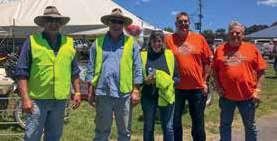


ridden any of the loops.
But as Andy pointed out there’s always next year.
“It’ll be the same again,” he glowed, “possibly we’ll offer a bit more of a specialist loop as well – like we did in
2021 when we went down into the gorge. We might try and do something along those lines for the more experienced riders.”
Awesome.
We’ll be there!

Riders is a group whose members share a love of riding, especially in the New England region of NSW. There’s an organised ride on the second Sunday of each month and all are welcome. Look it up on Facebook to get in touch.





Where does fear come from?
One minute I’m riding along having a merry old time, and the next there’s the beginning of a brick putting distance between my bum and undies. A corner comes up too quick, the front wheel slides, white van-man on the wrong side of the road (no really…last week), the ’bars get wrenched in my hands, something pops out at me, or I perceive a threat in a shadow or a bush. Many’s the time a threatening shape beside the road has had me thinking it’s trying to maim me. After sundown, my mind spins with threats hopping into my path.

A surge of the FAAAARK hormone courses through my body even if my training and skills sort it out with relatively little drama. Fighting the stiffen-and-freeze response is often done in retrospect; I give myself a solid talking to after the fact.
Strangely, when I was a senior Emergency Department Nurse, colleagues noted that the hairier a situation got, the quieter and calmer I became. I never froze and I never panicked. I was bloody good at that, and much of what I did and the way I reacted was
cultivated on top of knowledge and 20 years’ experience. I’m a very average adventure rider, and trying to cultivate a similar mindset while riding is not proving as achievable as I thought. My guess is that it’s a lot more visceral on a bike. The threat is far less existential. It’s physical and often in ‘yer face’. Most of us have kids and grandkids around us, and we notice how far spread along the continuum from timid to fearless they land from an early age. Maybe the timid never get into bikes. Maybe the higher skill level a biker achieves has to do with just how much their fearlessness borders on recklessness, especially when young and bruises fade quickly.
Is this the cornerstone of that elusive quality –‘natural talent’? I have strong memory of a nephew passing me as I struggled up a steep snotty hill, him on the back wheel, waving and calling out, “Come on, Uncle Andy!” – the little prick!
Winding on the throttle is against all basic sense… ‘if in doubt, power out’ is a skill learnt by fearless kids and takes time for an old fella to trust. When it does work (which it usually does), it brings an almost
Left: Andy’s anti-fear visor helps control the stiffenand-freeze response.
Bottom left: Anti-fear visor employed while tooling around home on a trials bike.
Below: The Home Gym: a cute Gas Gas.

euphoric wave of joy – “How good was THAT!”
In the theory of motivation Maslow’s Hierarchy of Human Needs, the second level, after stuff like breathing, eating and the like, talks of the need for safety, security and absence of threat. The urge to guard against injury or discomfort is innate and hard wired. Do the great riders ignore it or harness it in some way?
How do those riders who find great pleasure in treating their bikes like mountain goats, sweating, puffin’ ’n’ and blowin’, pushing the boundaries of sense and ability, do it?
Some people must thrive on the surge of adrenaline. I see reports on the news about kids outrunning the coppers for the thrill. Never in a million years would I have had a crack at that.
Obviously the more we train and practice the better we will respond. I recently did a trade with a mate and got myself what I call my Home Gym, a cute Gas Gas trials bike. Tooling around the slopes and embankments at home is improving my balance and reaction times.
still find myself extracting me and the bike from a bush after a frozen FAARK moment…I have a long road ahead.
In the meantime my anti-fear visor might help.














Dear Tom, How have you been? Hope you’ve recovered from that embarrassing medical condition you were telling me about. Did you try the hot poultice?
I’m writing to let you know that, unfortunately, I haven’t been able to do my column for this issue. Yes, I realise I often just scrape in by the skin of my teeth, but things haven’t worked out as expected and the amazing tale of epic red-dirt adventures I planned to share hasn’t eventuated.
I was only thinking the other day how it’s been a long time since joined you and your crew on my first big ride: leaving Coffs Harbour after the ANZAC Day dawn service and heading for Tibooburra. That was on that BMW650GS which I managed to write
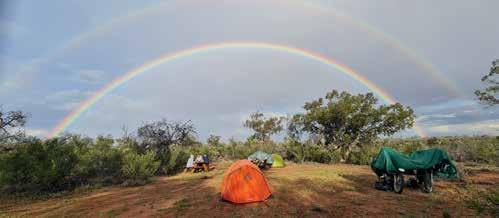
seem to remember you saying you hated sand, but as you were cruising along, taking happy snaps, you looked quite at home.
Anyhow, I’ve got a few moments on my lunch break, so I’ll fill you in on what’s happened.
You see, we did have a trip planned with our friends Greg and Kylie. She was in desperate need of a reddirt fix after the sudden passing of her mum, so a trip out to western Queensland was in order.
With all the COVID, lockdowns, floods, births, deaths, marriages and so forth, Dave (he sends big hugs by the way) and I have been getting a bit soft on the

altered route that didn’t include any of the places we had on our ‘to-do’ list but avoided flooded roads.
Now, I’ll have to give you a bit of back story here.
You remember our son Darcy? He came on one of your rides back in the day on the Dominator (we’ve still got it. It’s now lovingly referred to as a ‘project bike’. I probably have other names for it, but I think the firewall here at work will prevent me from including them in this email). His partner’s mum, Kathryn, is from Dirranbandi, and when we told her we’d visit her dad in St George on our way, she gave us the names of other people to say, “Hi!” to in Dirranbandi, too. So there was no shortage of people for us to meet.
I forgot to tell you. The Scrapheap Adventure Ride went to Dirran (after all the people we met there I’m practically a local now, so I can call it that) this year and stayed at the caravan park where we left our vehicles. They run a yearly ride to raise funds for Down Syndrome support.
Halfway through the ride Dave was a bit perplexed when he starting getting text messages asking how much he wanted for his ute.
adventure-riding and camping front. So much so that when we finally got away on this break, it took us twice as long to put up the tent because we’d forgotten how to do it – despite the fact the poles are colour-coded! Sheesh!
Anyhoo, our favourite human GPS had sorted a route taking in the Lake Dunn sculpture trail (a bit of artistic appreciation), Mt Moffat (a bit of walking and nature appreciation), bore baths (Kylie’s request) and Hell Hole Gorge, among other places. Two solid weeks were calling us, but, you know the old saying that includes mice, men and plans. It should really include something about flooding rains, although Dorothea sort of cornered that line. With a shortened length of time available to us, the bikes were loaded onto vehicles and we met up at Dirranbandi, ready to ride a much-
Far
Left: Got the gate unlocked.
Top right: Picking quandongs and generally strolling around like people on holiday.
Right: Comeroo late in the afternoon.
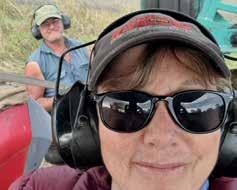
At the servo we got talking to the couple who owned the Back O’ Bourke gallery. Of course we promised to call in on our way through Bourke. Our new and improved route to avoid closed roads was going to take us from Hebel to Bourke, then onto Hungerford where we’d reassess road closures.
Emu late
With the sun shining and the tarmac dry, we were barely 20km out of Dirran when we came to the first (and basically) only patch of water on the road. It was only on the left-hand side, so we slowed to a respectful speed to go around. As Kylie was doing this, a bird-brained
u

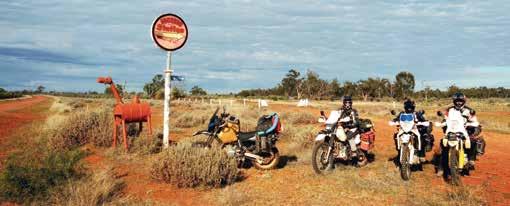

Above: A flat on the ute.
Top right: Dave trying a new ride at Moonie Qld.
Below: With Jenny and Steve from Back o’ Bourke gallery.
Below right: Owner of Hebel pub, Kathryn’s friend Frank.
Far right: The gymkhana at Hungerford was a hoot.
emu made the 100-metre dash out of nowhere on her left in a doomed attempt to cross the road in front of her. From the vantage point of riding behind her, the tyres smoked and sashayed, while the emu barrelled into the guidepost, flipped, rolled, got itself up and kept running. Kylie simultaneously saw the whites of its eyes and the puckering of its egg hatch as it passed in front of her with millimetres to spare.
Depending on how you look at things, it was either an inauspicious start to the ride or a very lucky one.

Our first night on the bikes found us looking for somewhere to stay before Bourke. You know, there’s something to be said for prebooking. Especially when you’re at a sign advertising camping and all you need to do is call – when you don’t have phone service!
Later in the trip it was fortunate we ran into the ranger at Currawinya National Park so we could go to the ranger station to use the wi-fi to book. I’m not sure how you feel about it, but I’m happy to pay the nominal fee because the powers that be can see there’s people using the parks and hopefully they keep them open to everyone…oh, and it was good knowing we were the only people booked at the campsite for the night….we weren’t. Back to night one where we got to another sign in front of a locked gate standing between us and some shearers’ quarters. With a bit of patchy service we were able to make contact, do a bank transfer and wait for that to go through before getting the code to the gate. If it wasn’t for the fact the four of us were very out of camping practice, we might have just camped at the gate.

When we rode into Bourke the next morning, Greg was salivating at the thought of eggs benny and coffee at our favourite eatery: the RSL. Imagine our shock to discover it had burnt down a year ago!
It was hard to come back from that disappointment (you know – you’re a coffee enthusiast), but we stocked up on supplies to hit the dirt (finally!) to Comeroo Station. Wouldn’t you know it, we got talking to a couple of blokes at the supermarket who were also going there. We were fuelled up and headed off to camp via the Back ’o Bourke gallery, with Greg and Kylie behind us, as we rode out of town.
We waited for them at the turnoff for quite a while, assuming they’d stopped to take photos of some interesting sculptures at the information centre. It turned out Kylie’s fuel bladder, tied on behind her, burst, spilling five litres of fuel over her! They were there beside the road, desperately dousing her with all their water, all the while hoping no one would throw a cigarette butt out their car window!


to say, the startled gallery owners weren’t expecting anything like the petrol-infused rider who dripped through their door.
However, Jenny and Steve couldn’t have been more helpful. They were amazingly hospitable, immediately getting Kylie into the shower to stop the burning and washing her clothes while opening their home to us and sharing stories of their art and town.
Despite the kindness we encountered, we’ve come to the conclusion, after this incident, the ill-fated ‘stuck out the back of Bourke on a black-soil road episode’ and the ‘could barely keep the bike upright between Bourke and Wanaaring ride’, that Bourke should be avoided on any of our future rides.
We got to Comeroo late in the afternoon and stayed two nights, in cabins (we must be getting soft – can we still be called adventure riders?), soaking in the bore bath, picking quandongs and generally strolling around like people on holiday.
to the metal
Our next stop was the bike and horse gymkhana at Hungerford. It was a hoot. The bike events were a true test of skill and luck – skill to negotiate the obstacles at speed, and luck not to run into other riders in the dust. To top it off, almost everyone we’d met since leaving Bourke was there too, including the blokes who gave us their trolley at the supermarket, allowing Kylie to return their shopping-trolley dollar. It’s an event I’d happily return to.
The talk among the locals at Hungerford was all about the impending rain and how the town would be cut off again in a few
days when it came through. There was also the new rule the four of us had made to not tackle any sort of road that could potentially be impassable with rain.
With that in mind we figured we’d better head east before then, but not until after we’d stayed at Currawinya National Park for a night.
It was gorgeous. It’s another place that deserves at least a week to explore properly, and it was there we finally had some sandy tracks. Greg and Kylie were in their element. I was feeling quite confident at my improved sand-riding ability…until Kylie said it was so damp that it wasn’t really sand. Oh well.
The wildflowers there, and on the whole ride, were simply stunning. It’s hard to grasp how much colour and variety is laying dormant or unseen, just waiting for the right conditions.
Unfortunately, the wheel bearing on Greg’s DR650 completely disintegrated as we were about to leave Cunnamulla. Fortunately, Dave had brought along spare bearings for the DR650. Unfortunately, Greg’s bike has a Husky front end. Fortunately, at the caravan park we were at, Greg sniffed out a family who’d just been to the Australian junior motocross championships and they had bearings. Unfortunately, they were just a smidgen too small.
So, the next day, we left Greg at the caravan park while the three of us rode the three hours to Dirran where Kylie loaded her bike and drove back to pick up Greg. Dave and I rode around for another day before we packed up and headed for home (and decided to take a couple of days to visit friends in northern NSW).
Oh, and on the way home, we got a flat in the ute. I can’t remember the last time that happened! Our spare was, we found out, not really suitable for a spare, so we stayed the night in a rather large town where, when I finally got the motelroom door unlocked, all the inglorious signs of the previous occupants were still there. It was up there with the pub room we stayed in that came complete with a crusty towel in the bathroom and a buzzer next to the door. I backed out in a hurry, wiped my shoes, got my money back and found another place to stay. It was much better. There was only kids doing blockies who ended up putting the car in the river out the back. Then there were a couple of hours of police and tow trucks sorting out the mess.
So, as you can see, it was a very different sort of ride, which is why I haven’t done the column yet. Apologies again. I can probably rustle up a story about camp cooking, or how to discreetly pee in the bush. Let me know. Take care.
Regards, K
R Emus lack any sort of selfpreservation skills
R Always keep an eye on the weather and road reports
R Be nice to people, you never know when you might run into them again
R Damp sand is my friend
R Do a test tent set up before camping with friends to avoid embarrassment

“Them’s
the breaks,” says Miles.
Sometimes it’s tricky to think of what to write about. Other times it seems easier. In this issue I’m writing about something I am currently going through: rehabbing from injury.
I came off my bike some weeks ago and banged myself up a bit. I’ve been through the injury/rehab journey before, and it’s never fun, but I do spend a lot of time on bikes, so unfortunately it’s somewhat a numbers game.
The trick is to be positive and focus all your energy on making a good recovery.
It happens
We ride bikes and sometimes we fall off them. We know the dangers and risks, but many of us can’t imagine life without riding. Somehow we need to find a balance: enjoying the thrill of riding, but be aware of the risks and manage them.
Some push the boundaries more than others, putting themselves at more risk. Others are very cautious and wish they could find a good feel with the bike and ride with a bit more spirit. Sometimes a crash is totally rider error and other times its totally out of a rider’s hands – a car pulls out in front of them, for example.
It’s nice to have luck, but you can’t rely on it. Eventually luck’s bound to run out. And the flipside is, a good rider makes their own luck by being aware of multiple variables and always factoring these into their decisions on speed, line selection and so forth.
The best way to avoid injuries is to not fall off in the first place.
Over the past 10 years writing articles for Adventure Rider Magazine I’ve covered a whole lot of techniques and strategies to achieve this. Things like various
accidents on mountain bikes, motocrossers, enduro and adventure bikes, and many times the first thing I do is simply turn around and park my bike with the hazard lights on in a place to show following riders there’s an issue. I sometimes tell the next rider to handle this while I check out the situation and work through the first-aid process. If you haven’t done a first-aid course you should, because if you ever need it, that knowledge is priceless.
Take the time to understand the level of injury and if help is needed, call
u


riding skills, fitness, riding gear, nutrition, hydration, fatigue and bike set up. Riders who focus on these have a much better chance of avoiding problems before they start.
It’s never nice to crash hard, to see a rider crash, or to come across a crashed rider. Depending on your level of experience in this area you may be quite freaked out, or be more calm and methodical. It’s common to see the person trying to assist put themselves and others in danger by parking their bike in a dangerous position as they go to offer help. Always think about how your actions may turn a very basic accident into a major one.
I’ve come across a few too many


immediately. Try triple 0, hit the SPOT Tracker or other emergency beacon. Get someone to ride to an area where a phone call can be made.
If the injury is less serious and you have other options you may choose to not call emergency services and self transport the rider to medical assistance. But don’t be shy to call for help if its serious.
If you’ve never hurt yourself and been hospitalised it can be a very intense and challenging situation when it first happens. It doesn’t make it any easier that you could be in a medicated state.
Luckily, in Australia, if you’ve been injured and transported to an emergency department (usually the closest public hospital) your life-threatening injuries will be attended to very well. Bone injuries, which are unfortunately very common in motorcycle accidents, are usually stabilised or splinted until you’re well enough for more definitive treatment or internal bracing with various metal
hardware options. During this short window you may wish to seek a further opinion, particularly if you have private health insurance. This is an acceptable option as it eases the burden on the public sector and can more often than not give better outcomes.
Based on my personal experience, if you do require surgery, I encourage you to seek a specialist’s opinion. You can also ask the doctors in the public hospital for a recommendation, but sometimes I’ve found they can take you seeking a specialist’s advice as an insult.
Think about it like your car. Some general workshops can take care of all mechanical repairs, where others specialise in one area, like brakes, suspension or gearbox. If you have a foot injury, there are specialist surgeons who only work on lower legs. There are knee, hip, hand/wrist and shoulder specialists also. In many public hospitals you will likely be operated on by a general orthopaedic surgeon, possibly not a specialist.

comprehensive rehabilitation meant I made the best possible recovery. It’s helped me carry on with my lifestyle with little or no major issues.
Think about all of the rehab situations out there. It goes from an older sedentary person recovering from an
Before I go any further, you need to realise there are two parts to a surgical healing process. The first is surgery and how well it’s done. The second is the quality of your rehabilitation, probably your physio and how hard you’re prepared to work to make a full recovery.
The best surgeon can only put the parts back together. If you don’t focus on your rehab you won’t make the best possible recovery. In fact, your recovery may be quite substandard.
Back to your decision on how to proceed with your surgery.
It really depends on your age, lifestyle, current location, insurance situation and so on. But if you have the option, it really makes sense a knee specialist does your knee, shoulder does shoulder and so forth.
I’ve had a couple of injuries in the past 25 years, and both were managed by a specialist. In both cases the prognosis wasn’t ideal, but the combination of the specialist orthopaedic surgeon and
With this experience I’ve also helped mates manage injuries.
They were in the public emergency ward being scheduled for surgery the next day. I was able to convince them to seek specialist advice before going under the knife, and the hospital staff to let me take them home. In both cases my mates thank me regularly.
It’s a very extreme comparison and I’m not dissing the public hospitals in Australia, but look at Toby Price when he broke is femur in South America. He was transported to a small hospital, can’t remember agreeing to any surgery, and woke up after the operation. Not surprisingly, it didn’t work out and a few months later he was having the original rod removed and he went through a second operation.
This process isn’t clear unless you’ve experienced it. If you or someone you know is in a situation, don’t be shy to ask. And don’t be shy to delay surgery for a day or so to seek a second opinion.
injury to a professional athlete looking to make a full, speedy recovery to get back in action. Where do you fit into this equation?
You can just go through the motions of showing up to a physio and push and pull a few TheraBands around and then stop going and put up with your average recovery for the rest of your life. Or you can embrace the challenge, find a good physio you can work with, and push yourself, sometimes into great discomfort, with the plan to make the best recovery possible.
In my experience, you have between six and 12 months to make your recovery. After that you have what you have. It makes sense to invest physically and emotionally in the first few months. You may find it pays off for years to come.
Get out there, enjoy your riding, take it seriously and hopefully you don’t end up needing any of this advice. But if you do, it’s good to have an understanding of your options.
Far left & left: if required, call for help immediately. A fast, competent medical response can make a huge difference to recovery times. Below: Take the time to understand the level of injury and if help is needed, call immediately.


Just as we were heading off to print Suzuki released some details and images of its new 776cc parallel-twin ’Strom. You read it right. It’s a parallel twin.
Adventure Rider Magazine is a huge fan of the V-Strom.
We admit we’ve always preferred the 650, but the 1050 shook our resolve a bit, and we were left amazed at how good the ABS and traction control were on that model. Still, the 650 will always be a favourite.
But now there’s an 800! That’s about the ideal size for a distance tourer we reckon. And the V-Strom’s history of low-cost ownership, high reliability and surprising versatility is unarguable.
Of course we haven’t ridden the new bike yet, and we normally heap scorn on magazines which regurgitate media releases as though they were well-researched and informative journalism, but we’re up against it a bit here. The printer’s screaming at us – he does a lot of that – and the publisher’s tapping his foot and frowning, so, after we’ve taken out as much of the marketing blather as we can, here’s what Suzuki said about the new bike…
Boasting the longest suspension travel and highest ground clearance of any V-Strom, the 800DE will hit Australia in mid-2023, powered by a new 776cc parallel-twin engine and featuring a steel
under the seat, is optimised to maximise torque at low rpm.
The 800DE is the first ’Strom supplied with a radiator guard. Suspension travel from the fully adjustable Showa suspension is 220mm at the front and rear, which is the same measurement for ground clearance. Spring preload is adjustable by hand on the rear.
A steel frame is engineered for the strength needed for off roading, and the seat rails feature a narrow profile. Spoked wheels – 21-inch at the front and 17-inch at the rear – have a corrosion-resistant coating and are fitted with Dunlop Trailmax dual-purpose rubber.
Front stoppers are dual 310mm floating-mount discs.
Suzuki has maintained the V-Strom ‘beak’ on the 800DE, but it’s now positioned higher. There’s a short, three-way adjustable windscreen, grab bars and a rear carrier which is also used as a mount for the optional top case.
A five-inch colour TFT screen with night and day modes is a step up for the ’Stroms, and there’s a USB port in the meter cluster. The indicators and vertically stacked headlights are all LED.
The bike is due in Aus in July 2023 in a choice of three colours: Champion Yellow No. 2, Glass Mat Mechanical Gray, or Glass Sparkle Black. The MSRP is $16,980 ($18,590 ride away).
The existing V-STROM 650XT V-twin will continue to be sold locally, in both full-power and LAMS configurations (Yay to that, we say).
frame, Showa suspension, wide tapered aluminium handlebars, and a 21-inch front wheel. Upgraded electronics include a gravel traction-control mode in addition to three standard settings, and the ability to switch off ABS at the rear. The Suzuki Intelligent Ride System incorporates multiple riding modes, an electronic throttle, bi-directional quickshifter, a quick-press easy-start system and Suzuki’s low-rpm assist to maintain engine idle speed during starts and low-rev running. The parallel-twin engine has a 270-degree crankshaft configuration with a patented Suzuki Cross Balancer – two balancers positioned at 90 degrees to the crankshaft – for smooth running. The Euro 5-certifed engine has maximum output of 62kW (83hp) at 8500rpm and peak torque of 78Nm at 6800rpm. Wet weight is 230kg, including 20 litres of fuel.
The bike has a highly efficient cooling system, two-into-one exhaust with dual-stage catalytic converter, and clutch assist. The six-litre air cleaner, positioned

Owners can select from a range of Suzuki Genuine accessories available via the Build Your Bike online tool on Suzuki Motorcycles Australia’s website. Items include three-pieces of branded hard luggage with optional locks which can be fitted for simultaneous use, engine and bodywork protection, heated grips, brake-pedal height adjuster, sidestand extension plate, centrestand, and variable height seat units (+/- 30mm).
Online pre-order customers who pre-order via the Build Your Bike on Suzuki Motorcycles will receive a bonus 38-litre alloy top case and bracket valued at over $1000. We’ll have to wait until we ride one, but it’s frigging tempting, eh?
Top left: Suzuki-branded top box and hard panniers with optional locks can be fitted for simultaneous use.
Top right: Fuel capacity is 20 litres, and the spoked wheels – 21-inch at the front and 17-inch at the rear – have a corrosion-resistant coating. Have a look at the ground clearance!
Top middle: The 800DE will hit Australia in mid-2023, powered by a new 776cc parallel-twin engine.
Right: A five-inch colour TFT screen with night and day modes looks the bizzo, and there’s a USB port in the meter cluster.
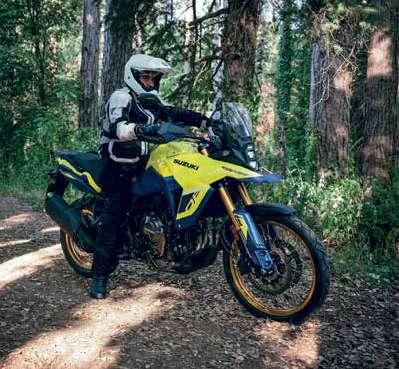

Above: The ADVWORX TREKK series of saddlebags is as tough as nails, and made from strong 1000D TPU. Below right: Designed to be practical, functional, lightweight, yet super resilient.
Right: The RideADV team has given the ADVWORX luggage a thorough flogging during research and development. If it’s tough enough to survive with this oufit, it’s tough enough to survive just about anything.
Top far right: 400D Ripstop inner drybags, each with their own air-purge valve.

ADVWORX is Adventure Moto’s own brand of practical, no-nonsense, made-for-Australia soft waterproof luggage.
During over 15 years in the industry Adventure Moto has continuously chased the best adventure products from around the world. While boss-man Steve and the crew aim to sell only top-quality gear, they’ve decided designing and manufacturing what they believe will be the world’s best adventure products is the go.


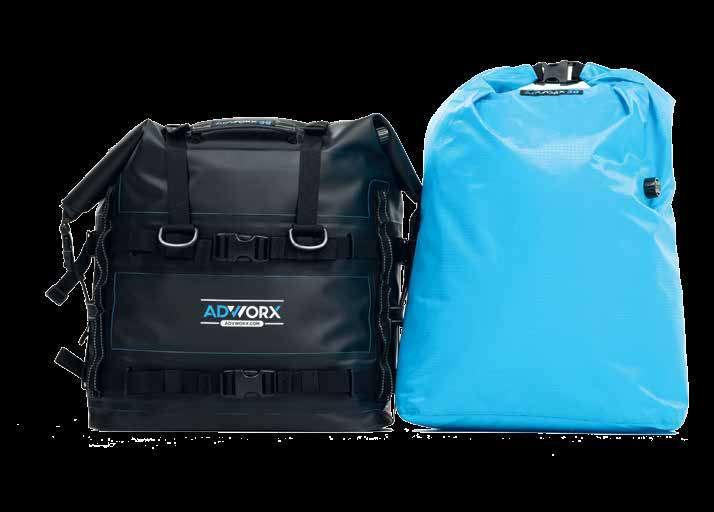
bags – or ‘soft panniers’, if you will – are as tough as nails. They’re made from strong 1000D TPU, which pretty much sets the standard for soft bike luggage. The bags are quick and easy to use with just about any pannier frames or a rear rack to strap a bag to.
What is 1000D and what is TPU Tuff?
Most motorcycle soft waterproof luggage is made using anything from 400D to 800D poly/nylon fabric. TPU stands for ‘thermoplastic polyurethane’, and is considered the bridge between rubbers and plastics, and while elastic and flexible, it’s extremely durable and strong. The Denier weight of a material is the unit measure in textiles for a linear mass of fibre within the material. The higher the denier weight, the stronger the fabric or textile per square measurement of surface area. So 1000D TPU is a very strong, highly abrasive-resistant material built for resistance to wear and tear.
Adventure Moto invites everyone to try ADVWORX products.
The range kicked off with soft luggage because it was soft motorcycle luggage which started Adventure Moto back in the day. Owner Steve Smith couldn’t find what he needed to meet his adventureriding needs in Australia, so he imported Wolfman Luggage, the pre-eminent brand back before Charlie and Ewen took the long way round.
And now the next step: designing and manufacturing equipment suited to, and ready for, Australia’s ultra-harsh conditions.
ADVWORX TREKK is TPU Tuff and includes soft motorcycle panniers, duffels and dry bags, and is 100-per-cent waterproof and 1000D TPU-tough. Strong PE liners and RF (radio frequency) welded seams mean gear stays dry and dust-free.
The ADVWORX TREKK series of saddle-
Designed for long-distance adventure touring, the ADVWORX range is extremely waterproof. RF welding is used to heatweld the seams and create a completely waterproof bag in even the harshest of conditions.
ADVWORX saddlebags connect to your choice of pannier frames using a simple four-point ‘hook’n’loop’ butterfly clip system borrowed from the original Wolfman Luggage designs. It’s simple and easy to use and works brilliantly. The tabs simply attach the bags to the frames while the compression straps secure
u


Above: Quick and easy to use with just about any pannier frames or a rear rack.
bag and gear tightly to the frame. Every bag in the ADVWORX range, including saddlebags, duffels and the new 15L and 25L drybags, includes an air-purge valve. Excess air can be squeezed from the bags for a trim and compact pack.
A few connection options are supplied, including easily removable over/under seat straps to connect the bags together, and now with the Gen-2 bags to be available in early 2023, a seat plate which will allow a duffel or dry bag to be strapped directly to the Hypalon, PE-reinforced soft luggage plate connecting the panniers. Riders will be able to strap bags between the saddlebags when the bike might not have a suitable rack or tie-down points.
Another option is a set of straps that connect a single pannier to the opposite frame, for when the rider only needs one saddlebag for a trip.
A lightweight, electronic, autonomous motorcycle airbag vest
R Detection and inflation time under 60 milliseconds
R Moisture-wicking, breathable, stretch-mesh vest chassis
R Compatible with motorcycle jackets that meet size requirements
R Fully wireless and autonomous (no sensors on the bike)
R Back protector offers impact absorption even without inflation

R Phone-app connectivity to detection options
R User-replaceable compressed inert gas inflator (must be replaced after each deployment)
R Vest chassis designed to be capable of withstanding three inflations (if post-inflation procedure is always followed)
Available from: Adventure Moto Web: adventuremoto.com.au
motoz trActionAtor duAl venture tYre
Designed to be paired with the Tractionator Adventure or Tractionator RallZ rear.
R 70% dirt/30% street
R Unique reversible tread pattern
R Available in tube and tubeless
R Stronger construction than most adventure tyres
R Self-cleaning and selfsharpening tread pattern
R Optimised hybrid natural/ synthetic compound
R Superior block and profile design
R Available in 90/90-21 tube-type, 90/90B21 tubeless, 110/80B19 tubeless and 120/70B19 tubeless
The straps can be quickly unbuckled from either bag, and a rubber grab handle allows easy carrying.
Highlights and improvements on the Gen-2 ADVWORX range, after much positive feedback from hundreds of new customers, include:
v Better quality spring-loaded buckles to resist load shearing
v Reflective MOLLE webbing to improve night visibility, AND
v 400D Ripstop inner drybags, each with their own air-purge valve.
Other than a few improvements to an already functional and high-quality packing system, ADVWORX’ 1000D TPU
Tuff luggage range is still the great product it’s always been, designed to be practical, functional, lightweight, yet super resilient. It may not have as
Straps connecting saddlebags, either over or under the pillion seat, make them easy to load and allow the bulk of the weight to be carried where the weight needs to be.
many bells and whistles as some of the more extreme brands, but sometimes form and function are just as important as design flair, and with some luggage brands Steve reckons there’s an overuse of materials.
After all, one of any adventure rider’s aims is to keep safe, dry and reduce weight where possible.
What’s down the track for ADVWORX?
The Adventure Moto design team is working on a range of products that include tankbags, a rackless luggage system, a range of durable-but-lightweight camping and sleep systems, bike accessories – including lighting –and a range of rider accessories. The main aim for Adventure Moto is to bring quality solutions to all riders at a reasonable cost. Compare the ADVWORX soft luggage range to many alternatives of lesser or similar quality and the savings will be a pleasant surprise – especially when it’s not a lower-quality product.
The comfort and protection of a full-face helmet with the light weight and ventilation typical of off-road helmets.
R Integrated sun visor
R Four inlet and two outlet vents
R Washable sweat-wicking liner
R Sizes XS – XXL
R ABS shell
R Interchangeable clear visor with multi positioning
R Matte black, gloss white or fluro (yellow)
R Helmet bag
RRP: $198.00 black/white. $219.00 fluro
Available from: All good motorcycle shops, or from eldoradohelmets.com

Web: eldoradohelmets.com


Available from: Your local dealer Web: motoz.com.au

rAd guArd YAmAhA t700/ Xt700 2019 – 2022
An essential aftermarket part.
R For the hardcore adventure rider
R Easy to fit
R Fitting instructions provided
R Lightweight and doesn’t restrict airflow
R Made from 6060
T1–T5 aluminium
R Available in black or polished aluminium
R Three-year worldwide warranty
R Australian made

RRP: $225. On special for $179
Available from: Rad Guard Phone: (02) 6658 0060 Web: radguard.com.au

Act drz400 Wide rAtio geAr set
Suzuki DRZ400 wide-ratio gearbox kit by Advanced Clutch Technology USA.
R More versatility
R Heat-treated and case-hardened gear steel
R Robust engineering, precisely machined and precision ground
R Recommended for dualsport adventure, street, desert or supermoto
R Incrementally spaced second thru fifth gear ratios that make sense for all riding needs
R NOTE: shift-fork mods are required for the installation. Instructions are included. Modified shift forks are also available via order.
RRP: From $1149 plus postage
Available from: Adventure Bike Australia
Web: adventurebikeaustralia.com.au


A set of side frames to support Andy Strapz soft panniers.
R Intended to support throw-over bags that have the weight taken on the seat
R Carefully considered stress and impact areas
R Accommodates most throw-over bags and all Andy Strapz pannier systems
R Avduro Panniers are the best choice, of course
R Fitted in minutes with a single Allen key
R Run without pillion seat or footpeg brackets
R Frame weight: two kilos with all fittings
R Mild steel, powder-coated satin-black with stainless bolts
RRP: $395 plus post
Available from: Andy Strapz
Phone: (03) 9786 3445
Email: info@andystrapz.com
Web: andystrapz.com



R


& becKer tAnK
blAcK for ducAti desertX
The bars follow the lines of the bike giving a customised appearance.
R High-quality German steel tube
R Made in Germany
R Protection during pushovers or falls
R Premium surface finish
R Easy assembly
R Delivery: right side, left side, mounting kit and manual
RRP: $469
Available from: Motorcycle Adventure Products Phone: 1300 898 560
Web: motorcycleadventure.com.au
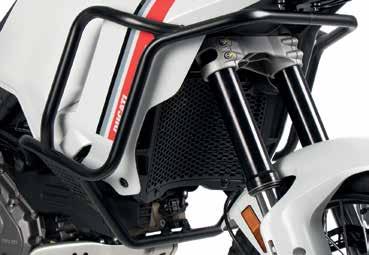
second generAtion sAddle bAg
A 100-per-cent waterproof luggage solution.
R 1000D TPU construction
R 400D Ripstop saddlebag liners
R RF-welded seams
R Four-point ‘hook’n’loop’ butterfly-clip system
R External air-purge valve
R Cross over/under seat straps
R Includes additional straps for single saddle-bag mounting
R Internal PE board insets
Available from: Adventure Moto Web: adventuremoto.com.au

motopressor pocKet pump combo pAcK
Everything needed to repair a puncture and inflate a tyre in one handy kit.
R Pack includes Pocket Pump, puncture-repair tool and in-line tyre gauge
R Everything fits into the neoprene bag (180mm x 179mm x 90mm)
R Weighs 1250g
RRP: $161.85 plus postage and handling
Available from: Rocky Creek Designs, motorcycle shops, or through Pro Accessories Web: rockycreekdesigns.com.au

lYngbY Air Adventure pAnts
Engineered using Gore-tex® Pro fabrics for comfort and weather protection.
R Removable internal inner liner included
R Level 2 certified EN 1621-1 protection for the removable knee guards
R Adaptable for use in all climates
R Windproof, waterproof and breathable membrane and coating
R Reflective 3M™ Scotchlite™ materials
R Built-in hip padding
R Jacket and pants can be connected by a zip
R Have the GUARANTEED TO KEEP YOU DRY™ promise
RRP: $895 Available from:






















